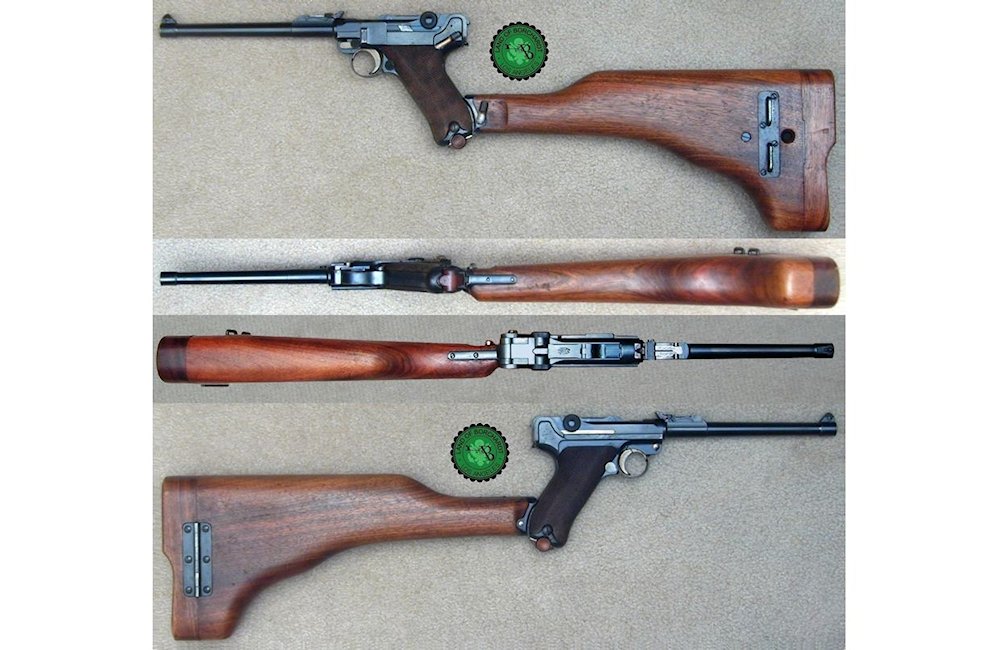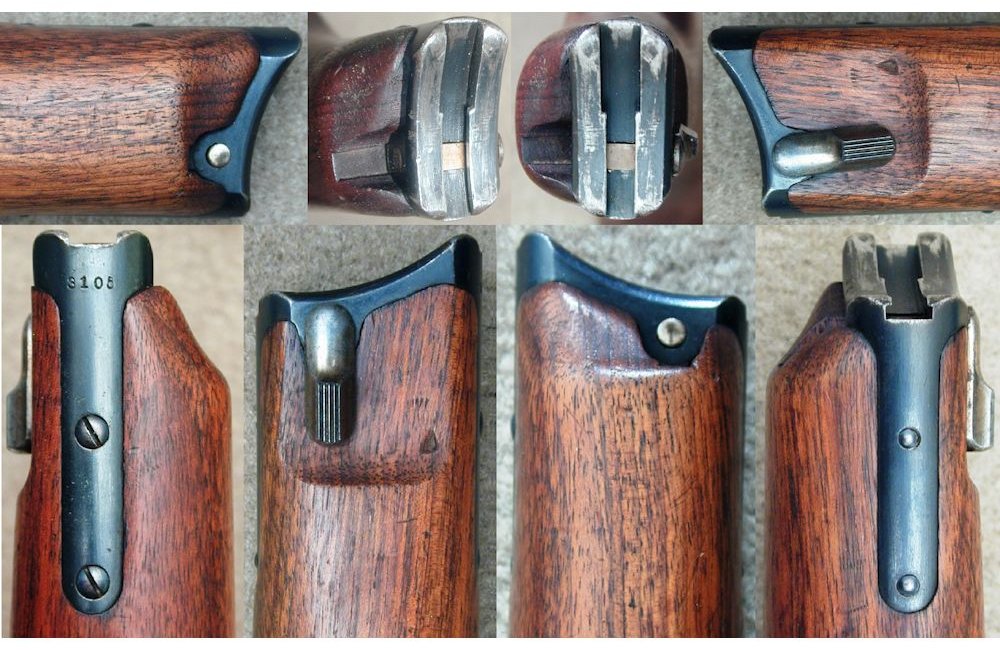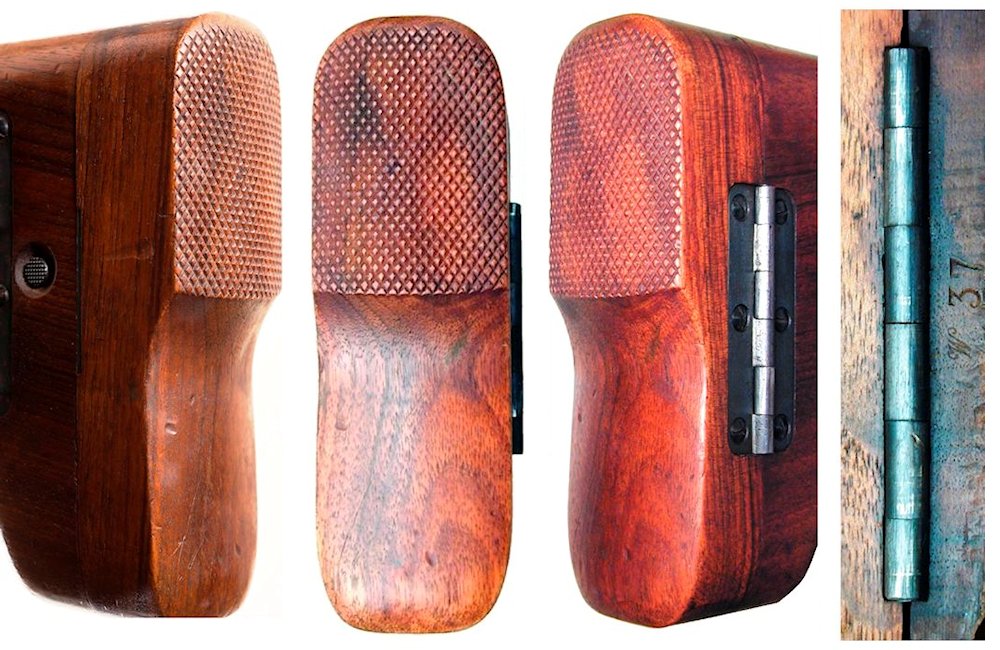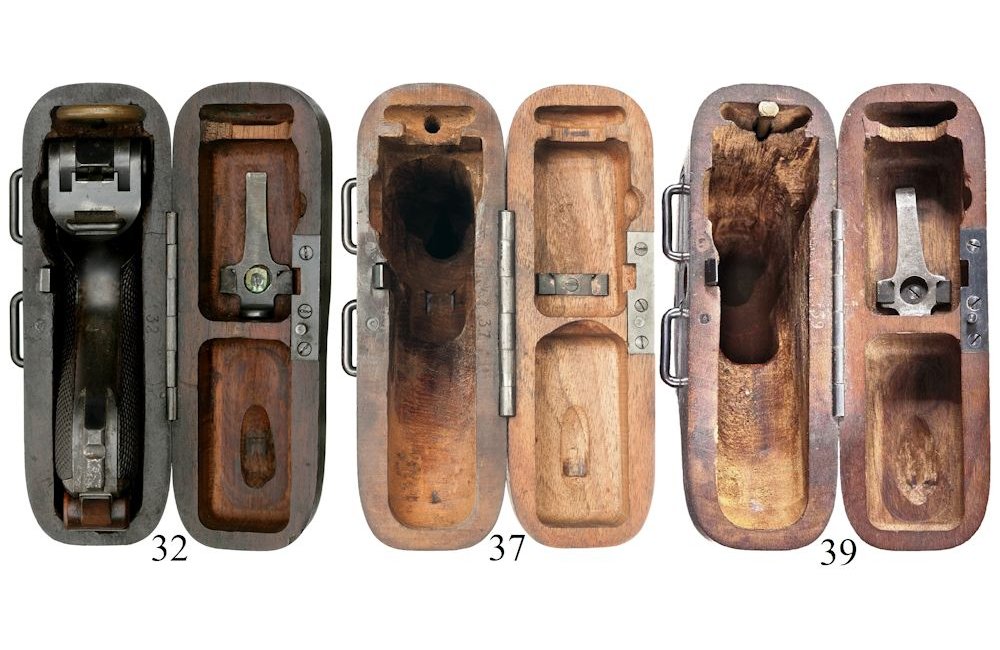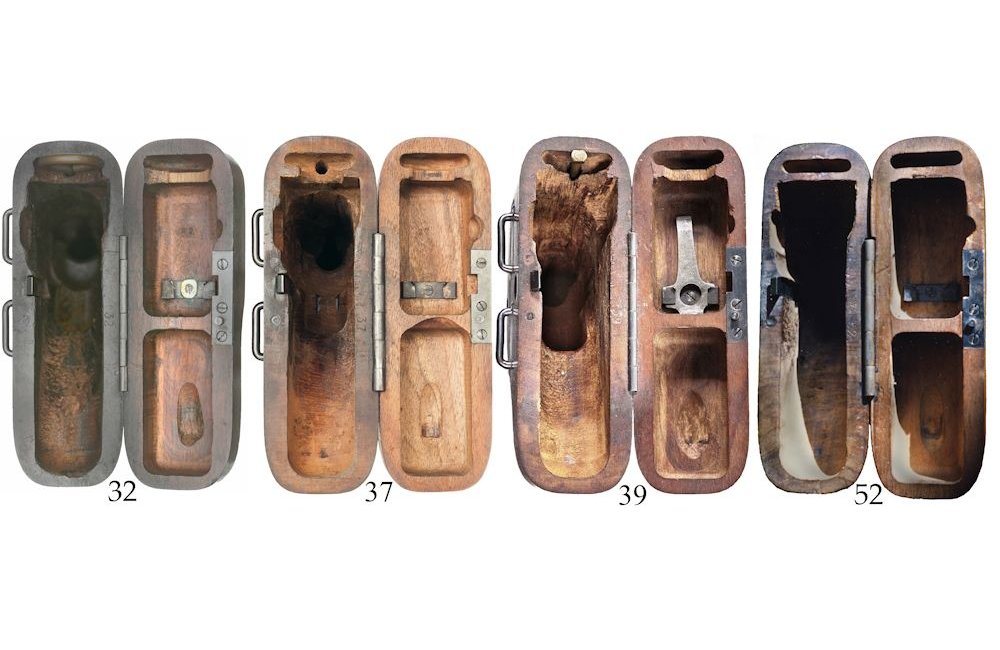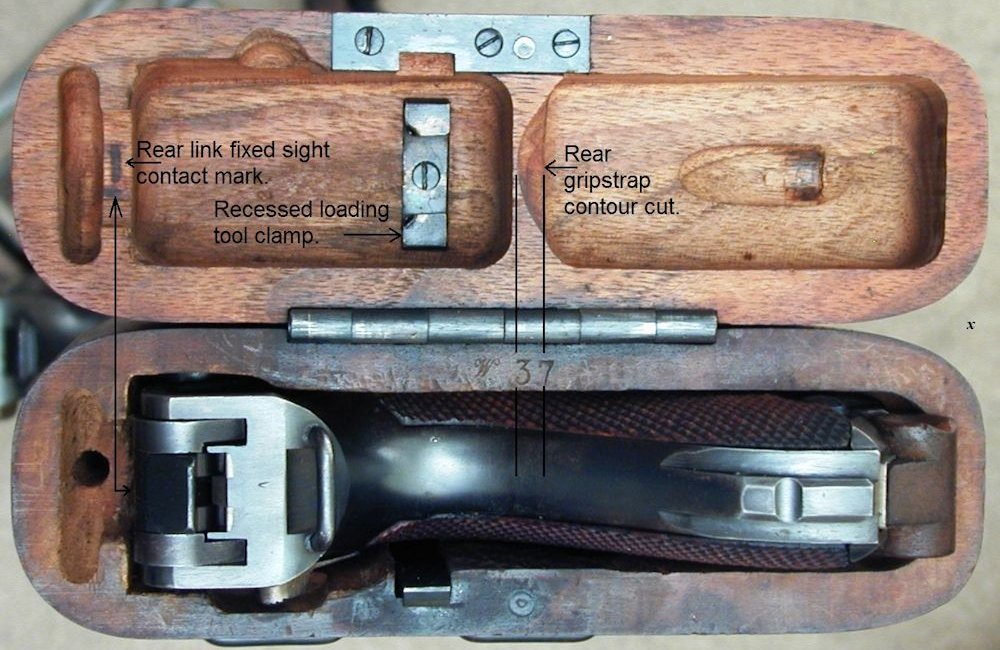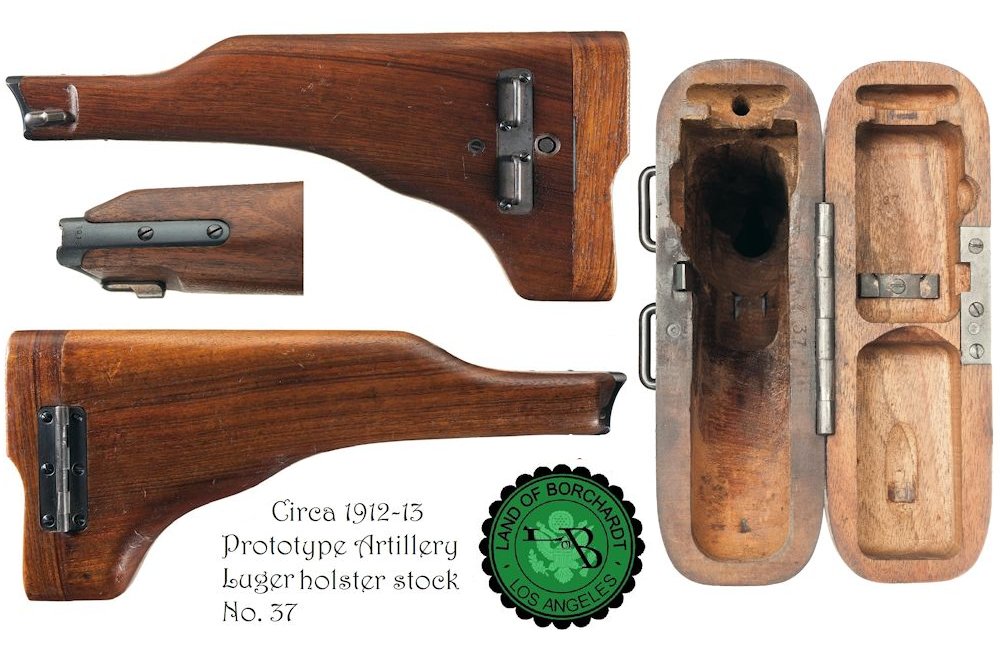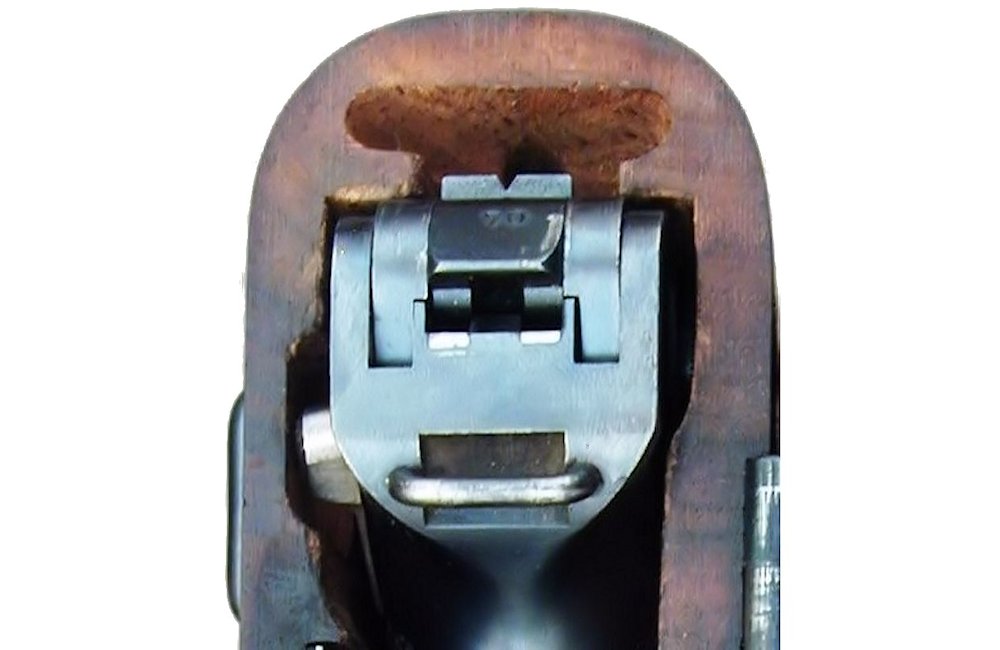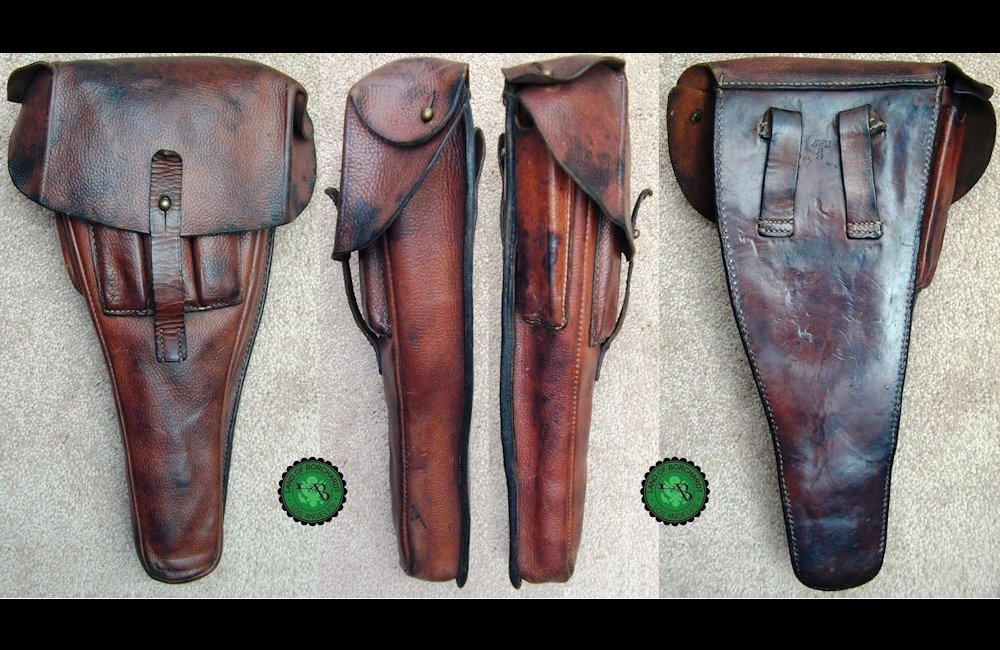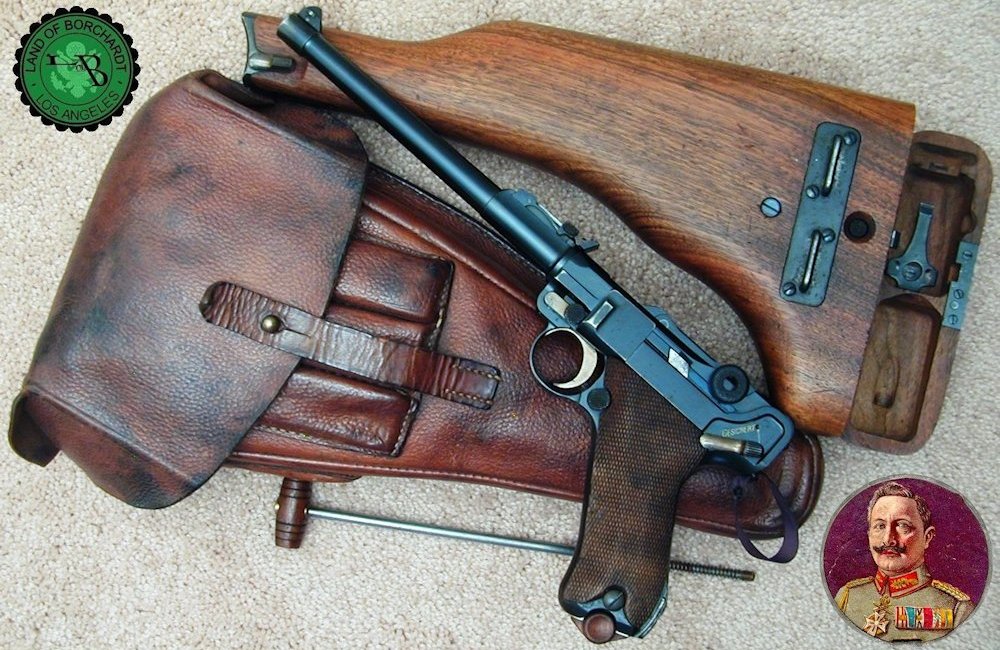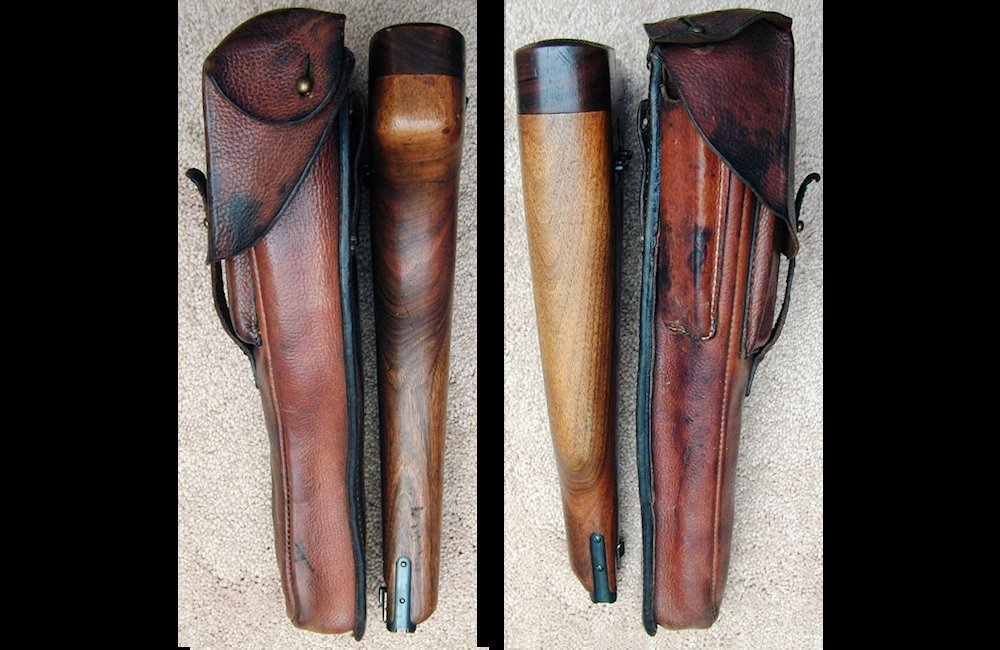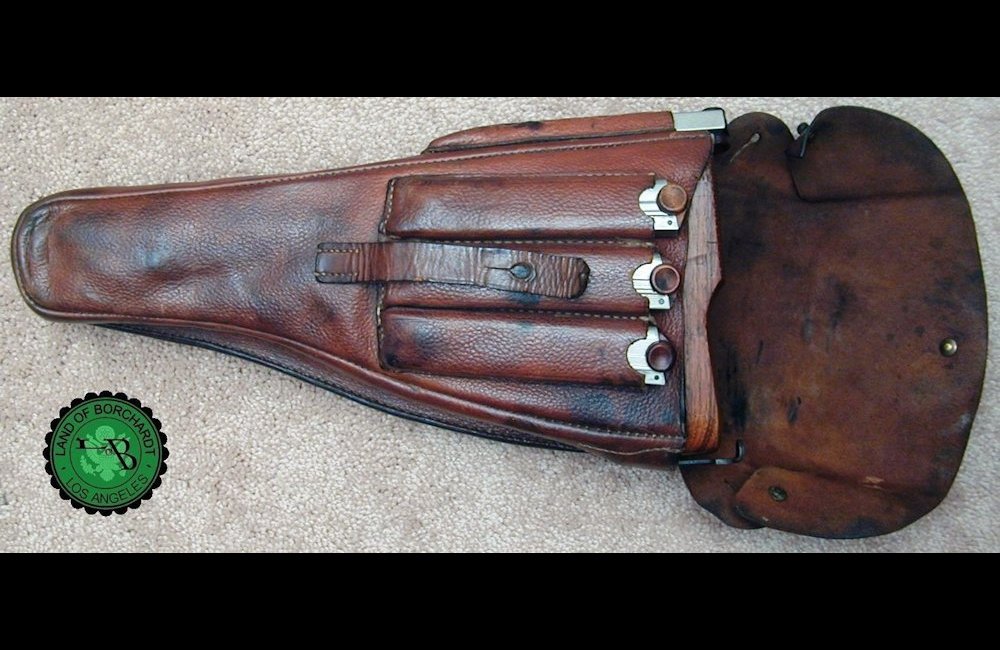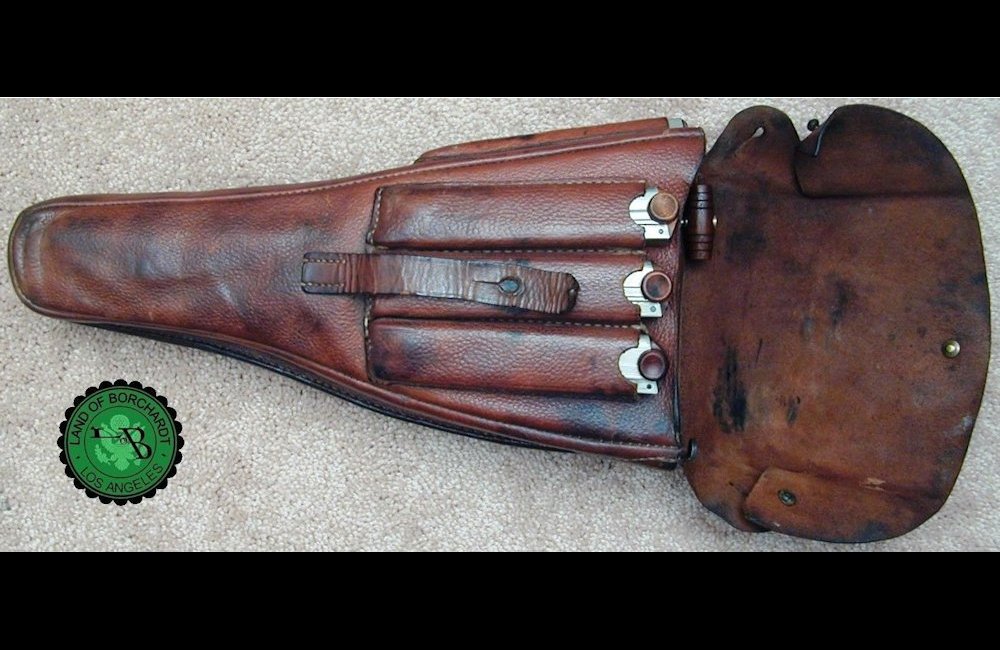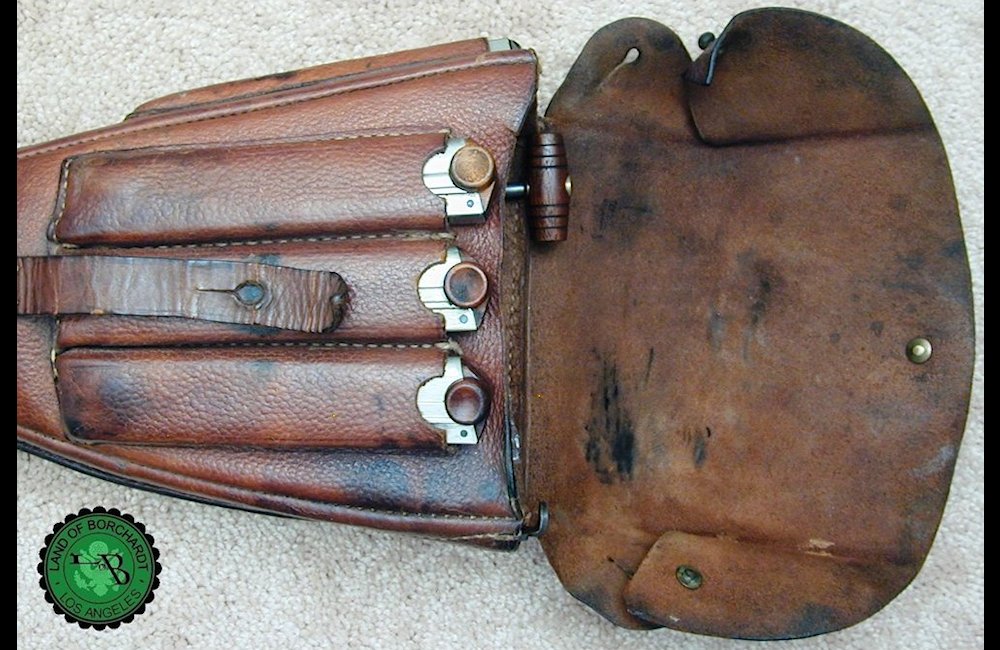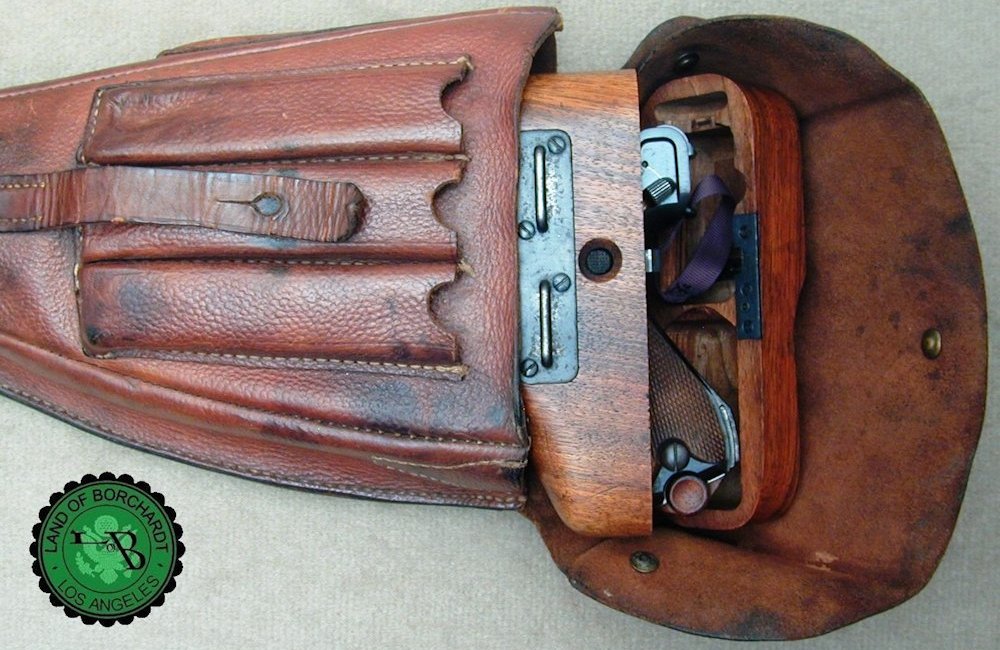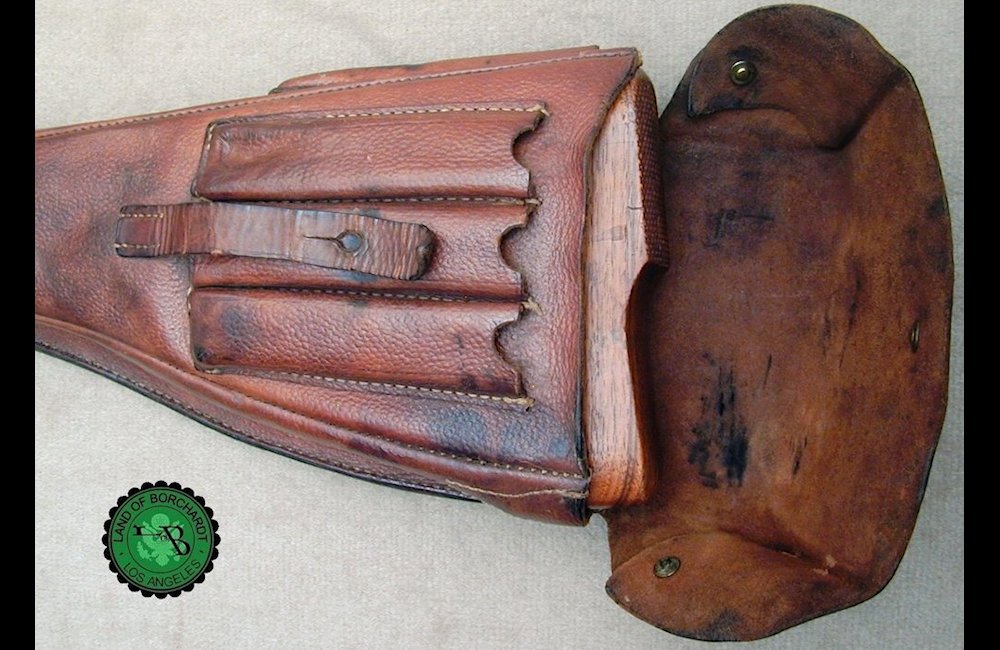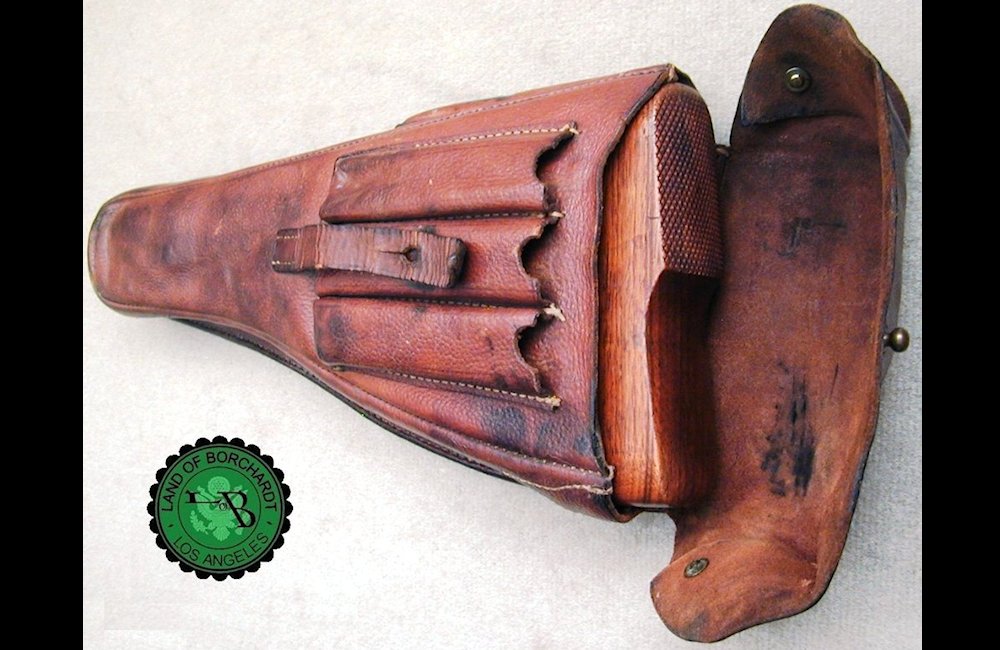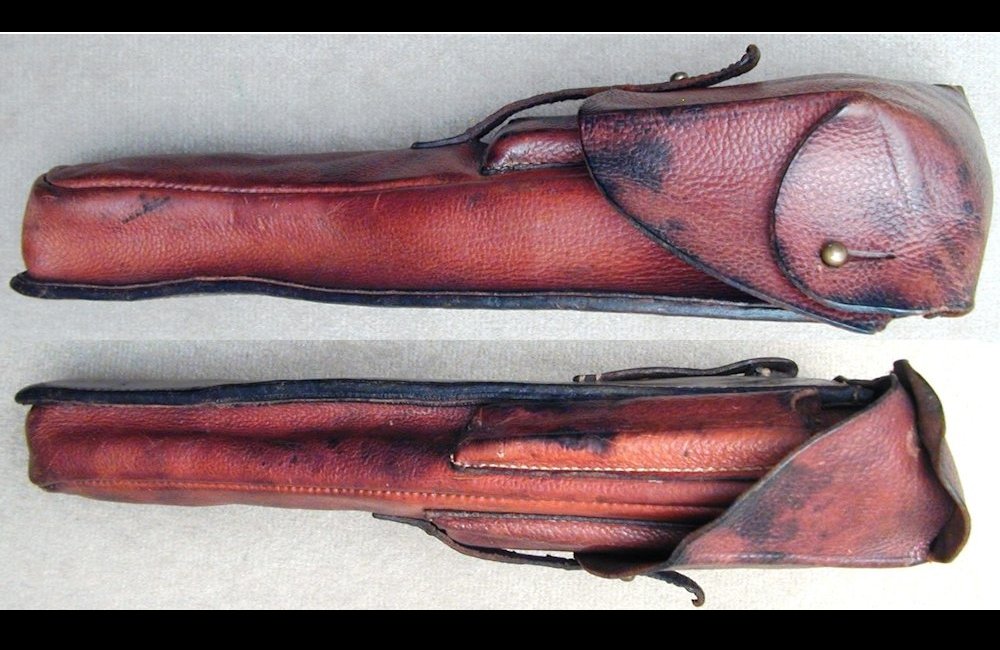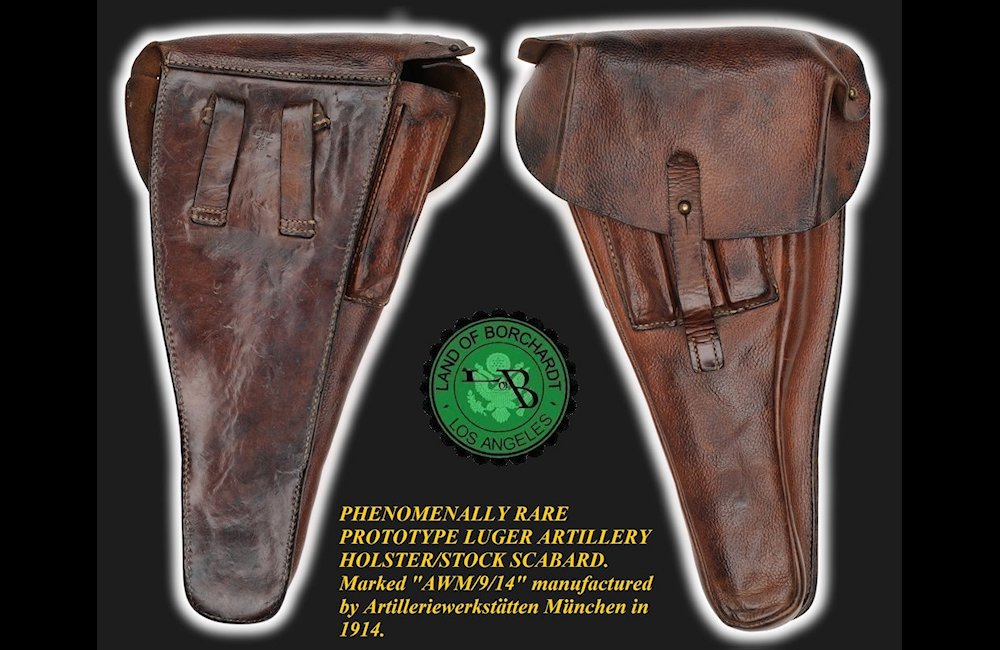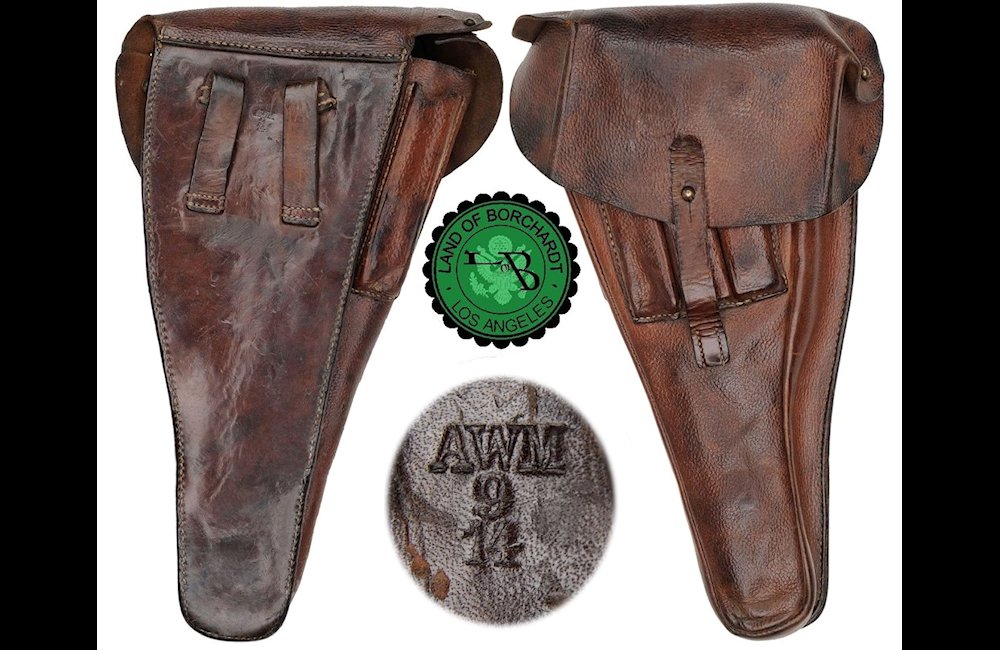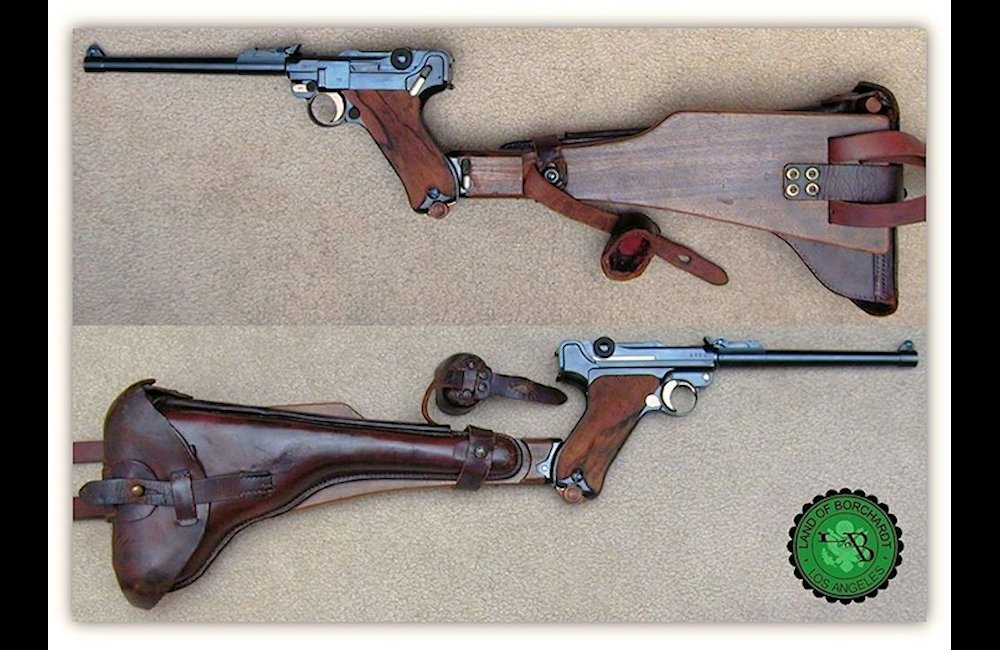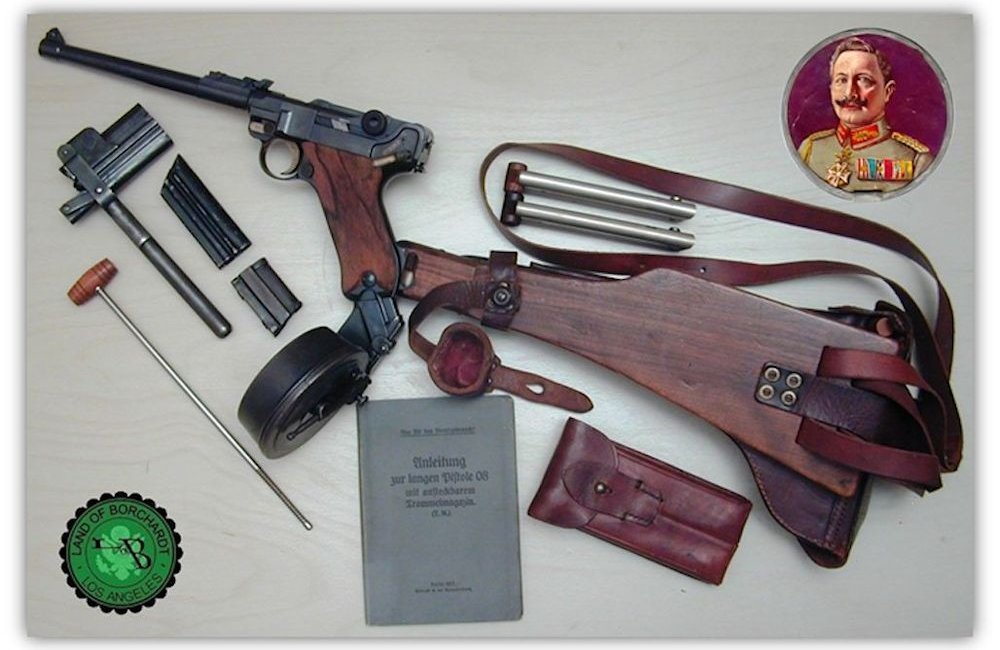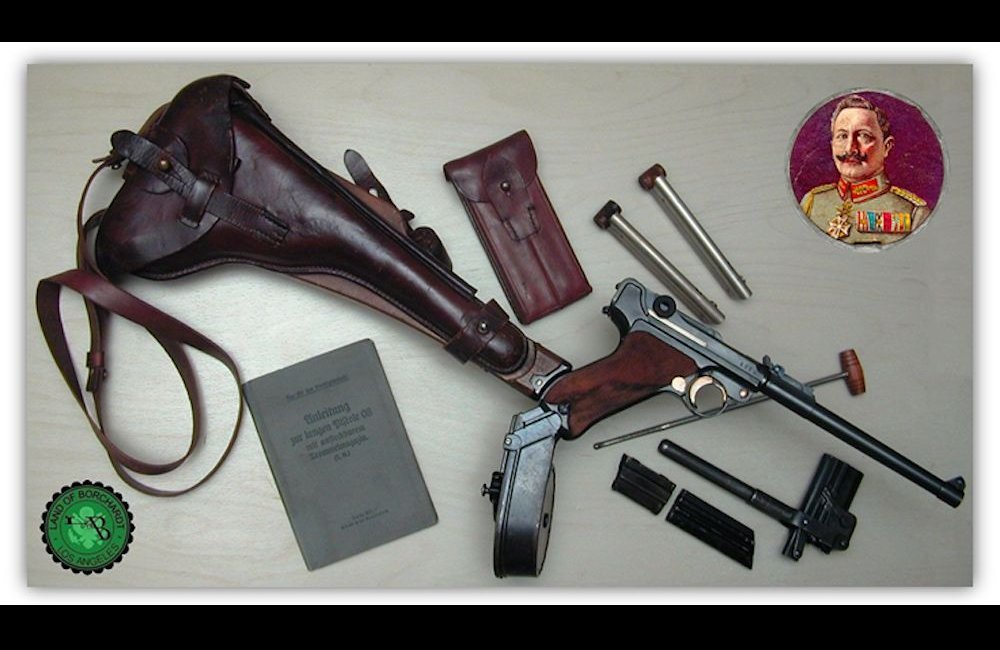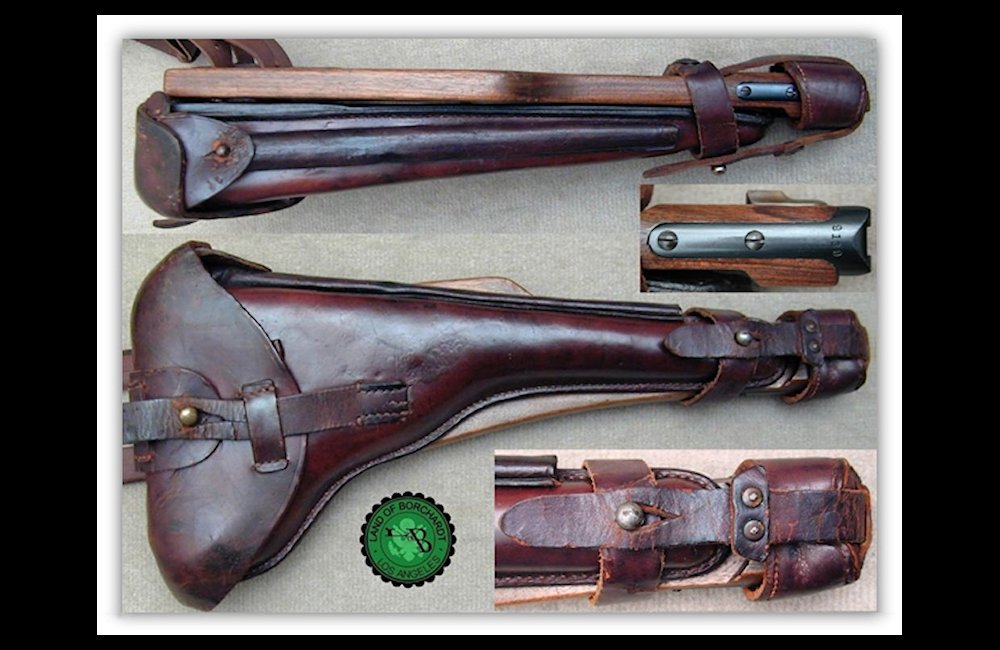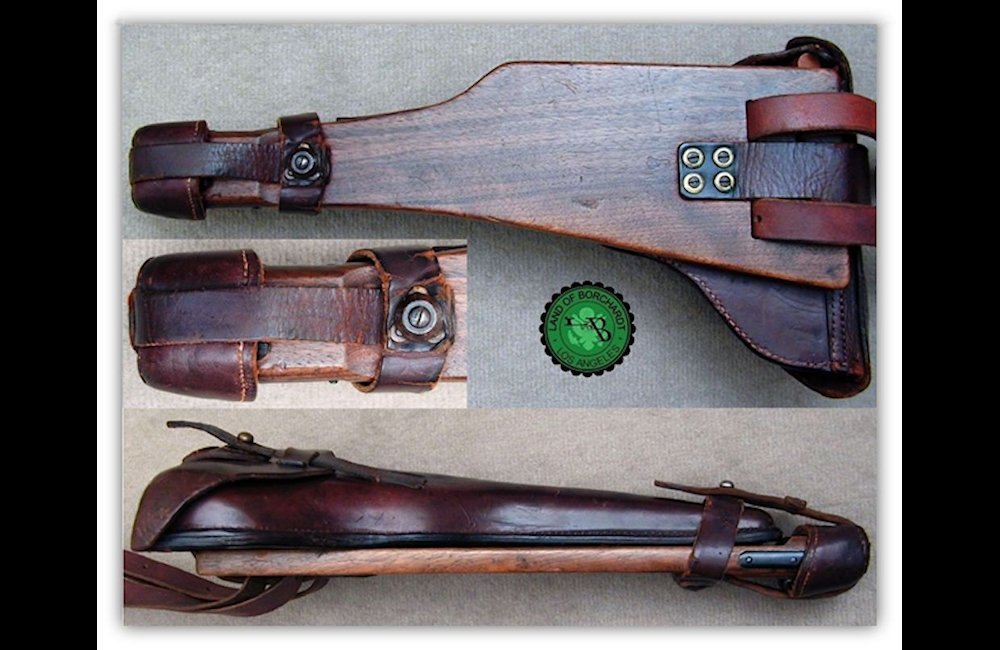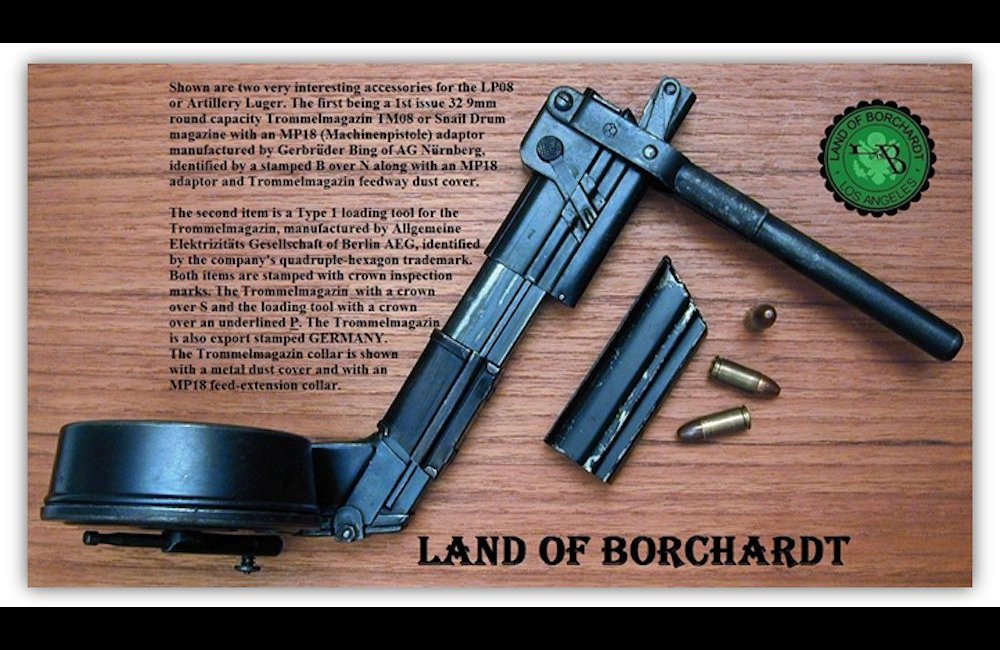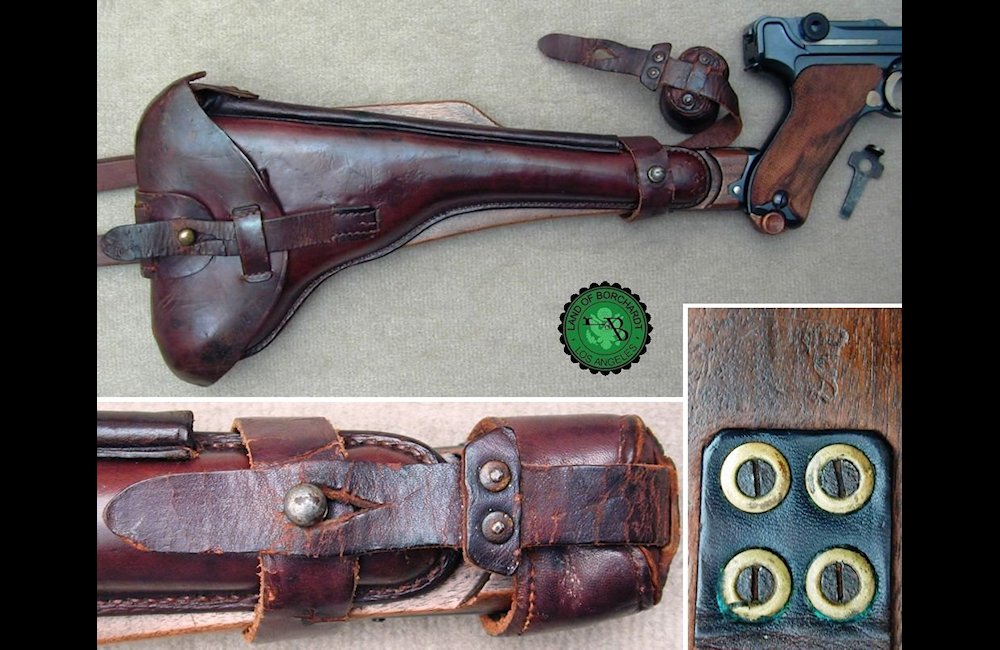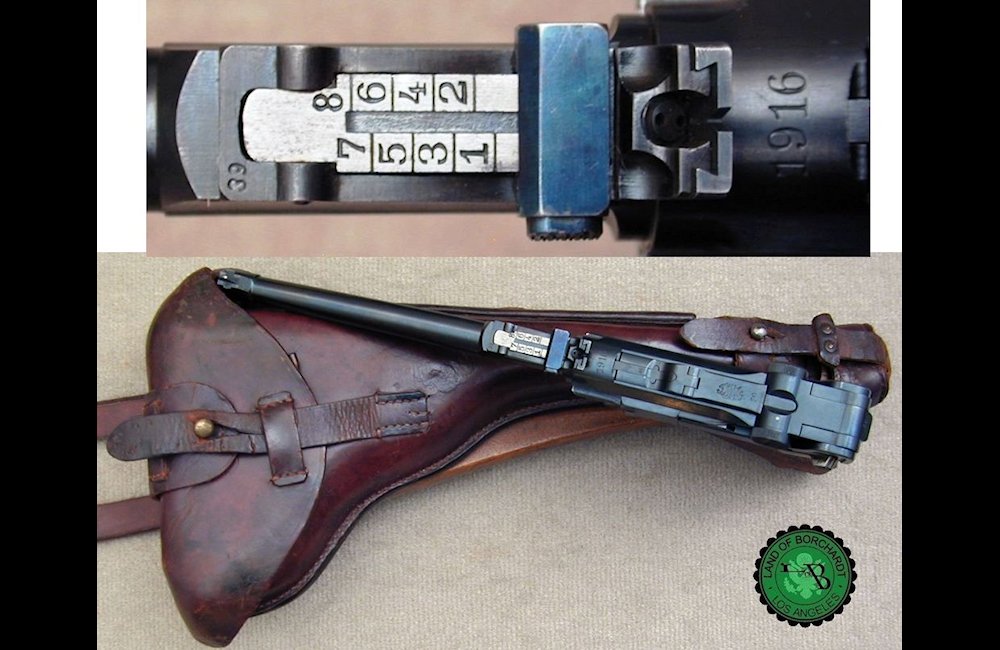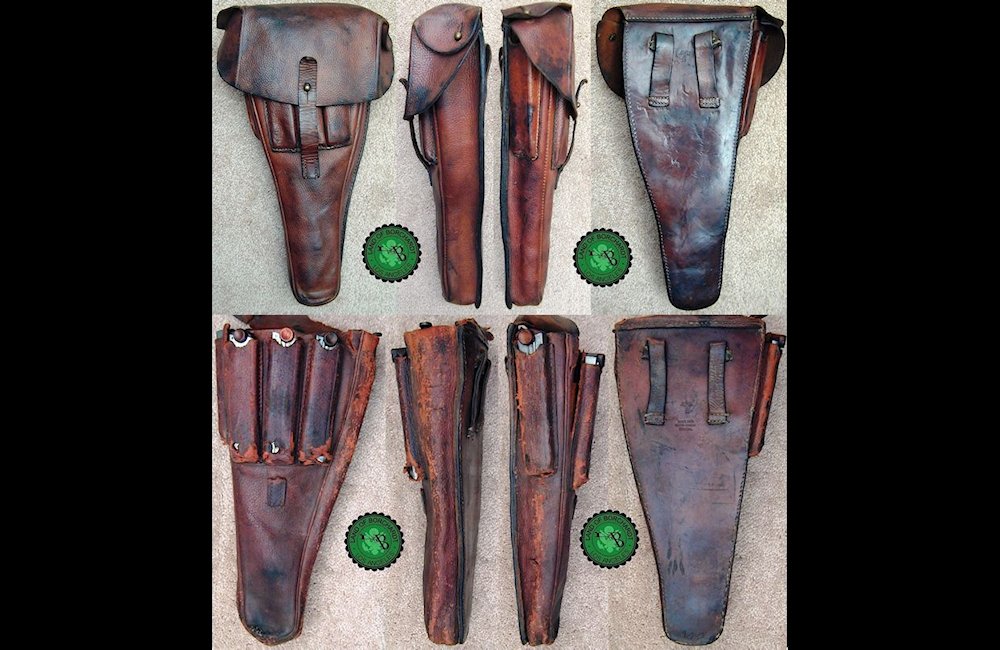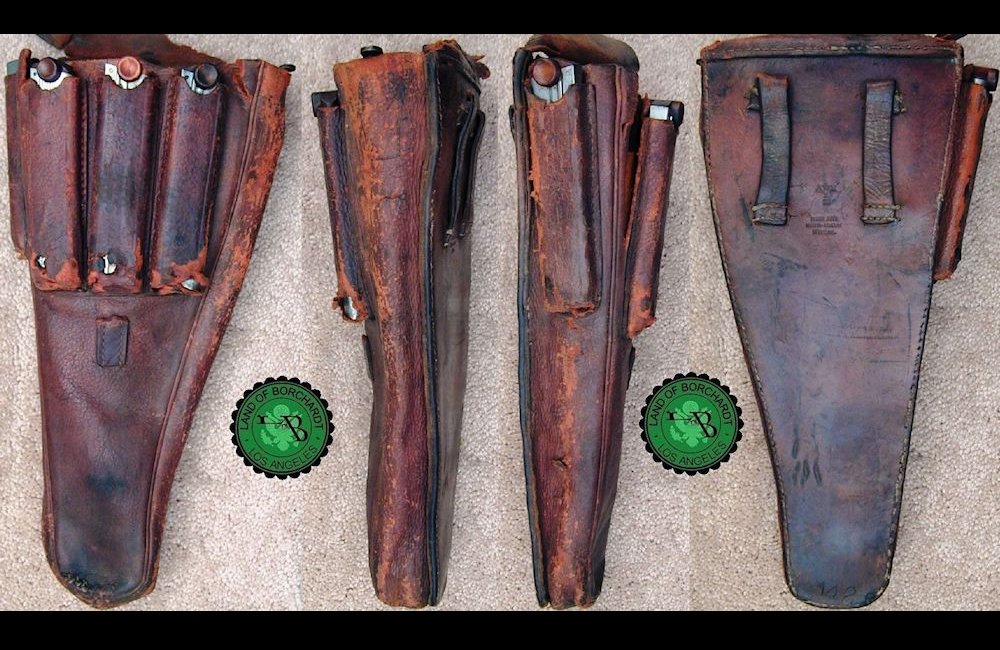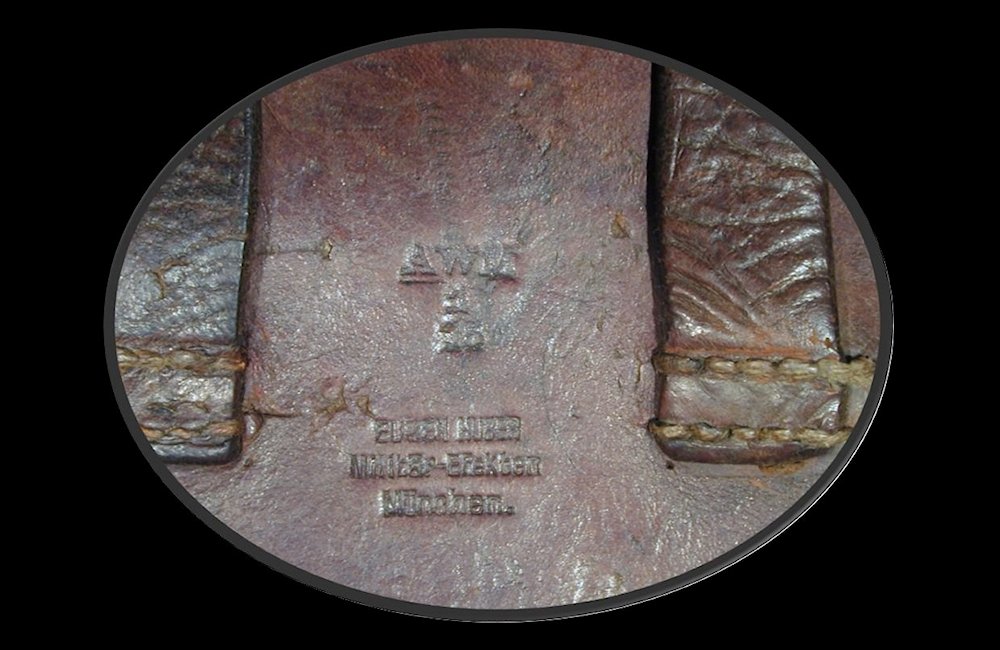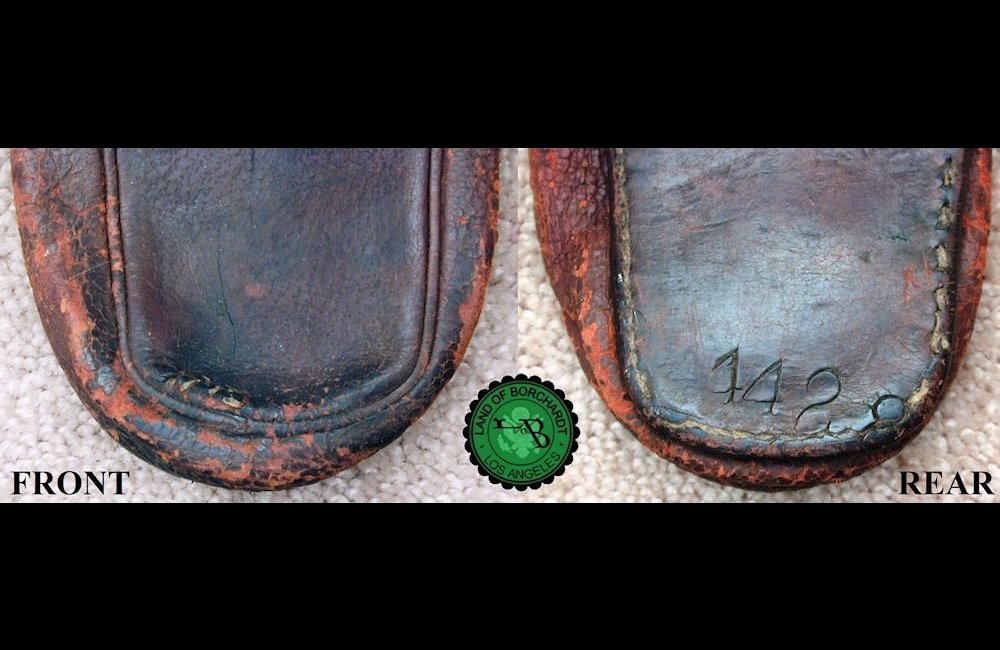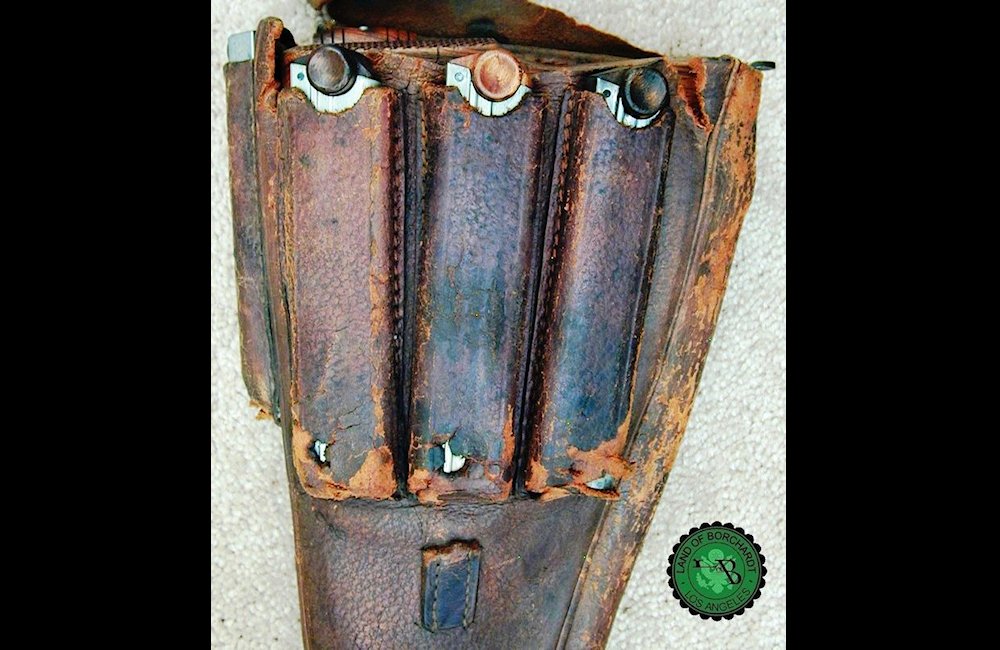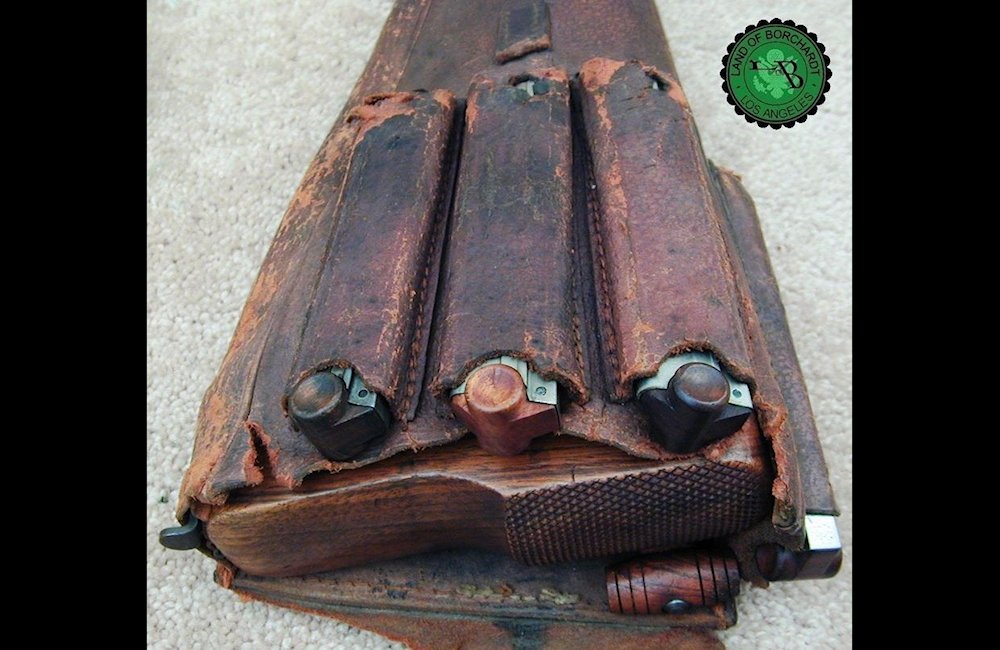buttons
The following is a discussion of the Imperial German army troop trials Artillery prototype, solid body wooden holster-stock made for the approximately 20 – 50, circa 1913 DWM manufactured prototype Artillery Lugers. This discussion is specifically focused on:
a) The auction acquisition of prototype Artillery Luger holster-stock number 37 .
.
b) The auction acquisition of prototype Artillery Luger holster-stock scabbard AWM 9 14.
This site has a previous article on the prototype Artillery Luger, written as a result of the acquisition of prototype Artillery Luger, serial number 11 with an additional section discussing the mating prototype holster-stock and
other Artillery holster-stock configurations. Since this article was published more information has been obtained, and with the acquisition of heretofore unknown troop trials prototype Artillery holster-stock number 37/3105 and an AWM 9 14 dated prototype holster-stock leather scabbard, and with subsequent
detailed examination, more information and certain specifics are presented.
with an additional section discussing the mating prototype holster-stock and
other Artillery holster-stock configurations. Since this article was published more information has been obtained, and with the acquisition of heretofore unknown troop trials prototype Artillery holster-stock number 37/3105 and an AWM 9 14 dated prototype holster-stock leather scabbard, and with subsequent
detailed examination, more information and certain specifics are presented.
The only comprehensive and detailed information written to-date, in an excellent, expansive treatise on the prototype Artillery Luger holster-stock is presented by †Görtz/Sturgess, first in the 2010 publication titled: Pistole Parabellum and later, essentially unchanged, in the 2011 – 2012 publication titled: The Borchardt & Luger Automatic Pistols
and later, essentially unchanged, in the 2011 – 2012 publication titled: The Borchardt & Luger Automatic Pistols , aka TBLAP. Since the surviving author prefers the later publication, it is presented herein and will be referenced throughout. Also presented is the auction house description and pictures of prototype Artillery holster stock number 37 and prototype Artillery holster-stock leather scabbard.
, aka TBLAP. Since the surviving author prefers the later publication, it is presented herein and will be referenced throughout. Also presented is the auction house description and pictures of prototype Artillery holster stock number 37 and prototype Artillery holster-stock leather scabbard.
The identity and acquisition of prototype Artillery Luger holster-stock number 37 makes a total of four genuine and authenticated examples, out of a possible total of 20 – 50 examples, depending on which author one believes (Kenyon 50 or Sturgess 20). Using twenty as a base-line and calculated as a percentage indicates a 20 percent “published” survival rate. Assuming there are an equal amount in unpublished collections, makes a total of eight or 40 percent. This does not account for unidentified surviving examples, which could push the total to possibly 10 or 50 Percent. With that said, does not diminish the rarity of these surviving examples, resulting in a limited supply, combined with an unlimited collector demand, pushes the value into the stratosphere, and as in a statement by a serious, knowledgeable Luger collector in response to a fellow collector query on an offered solid body Artillery holster-stock: The originals are almost priceless...the repros a few hundred. How's that for a range! Seriously, the chances of it being one of the prototype wooden stocks for the ultra-rare 1913 Artillery are astronomical. There were really nice close repros made 10-15 years ago and that is probably what you will see. Pictured is the auction catalog description of prototype holster-stock 37/3105.
Pictured is the auction catalog description of prototype holster-stock 37/3105.
The troop trials of the prototype holster-stocks/leather scabbard Artillery Luger carbine rigs could not have lasted for more than a few months at most, being tested in a relatively benign environment, and there is no evidence that the few troop trials prototype Artillery holster-stocks were used during the war, so a reasonable assumption would be that they were simply stored by the Imperial German army for the duration of the war, as attested by War Ministry correspondence dated 16 June 1913 [1],to be excessed in the 1920s or 1930s. Since wood is a relatively perishable product, the relatively good condition of the few surviving examples is testament to a sheltered storage environment for the last 100 years, first by the army and later by subsequent owners and collectors.
[1],to be excessed in the 1920s or 1930s. Since wood is a relatively perishable product, the relatively good condition of the few surviving examples is testament to a sheltered storage environment for the last 100 years, first by the army and later by subsequent owners and collectors.
Known prototype Artillery Luger holster-stocks
Holster-stock number 32, attaching iron serial number 226C, aka 32/226c. G. Sturgess Collection.
Holster-stock number 39, attaching iron serial number 5464, aka 39/5464. Collection status unknown.
Known prototype Artillery Lugers
Prototype Artillery Luger serial number 4. G. Sturgess Collection.
Prototype Artillery Luger serial number 11. Land of Borchardt Collection.
Prototype Artillery Luger serial number 37. The late Pat Redmond Collection.
Artillery prototype holster-stock number 32, attaching iron serial number 37(x) is featured in The Borchardt & Luger Automatic Pistols by †Görtz/Sturgess and is pictured in Fig. 14-32. Per correspondence with G. Sturgess, when queried about the discovery and acquisition of the subject prototype Artillery Luger holster-stock 37/3105, responded with the following: I have no idea where these have been hiding all these years, as I had not come across an open market example in 30 years until wood sn 39 appeared that Hermann Historica offered in 2010
Per correspondence with G. Sturgess, when queried about the discovery and acquisition of the subject prototype Artillery Luger holster-stock 37/3105, responded with the following: I have no idea where these have been hiding all these years, as I had not come across an open market example in 30 years until wood sn 39 appeared that Hermann Historica offered in 2010 - I got mine from Henk Visser, and he had had it since the 1950s. The only other example I physically examined was Pat Redmond's which was all original, with iron no 37/wood sn 52, [with] matching pistol sn 37,
- I got mine from Henk Visser, and he had had it since the 1950s. The only other example I physically examined was Pat Redmond's which was all original, with iron no 37/wood sn 52, [with] matching pistol sn 37, as illustrated in the book Fig. 14-32, with my example with wood no 32.
as illustrated in the book Fig. 14-32, with my example with wood no 32.
Sturgess comments regarding the origins of prototype Artillery holster-stock 32 create chronological inconsistencies as research shows holster-stock 32 was first
pictured in Kenyon’s 1969 Lugers at Random on page 390, credited to “The John Gabrick Collection” with a caption description stating the attaching iron has a two-digit stamping with a letter suffix. The identity of 32 is also confirmed by the loading tool retention clamp added brass washer shown in Fig. 14-32
The identity of 32 is also confirmed by the loading tool retention clamp added brass washer shown in Fig. 14-32 , yet Fig. 14-32 is pictured with a 37 stamped attaching iron, while in the same figure showing 32 internals, implying two attaching irons stamped 37, being the late Pat Redmond holster-stock 52 attaching iron also stamped 37. It has been determined by a personal examination of the number 32 stamped wooden stock, while on display in possession of J.D. Julia, prior to auction, that the attaching iron is stamped 226c
, yet Fig. 14-32 is pictured with a 37 stamped attaching iron, while in the same figure showing 32 internals, implying two attaching irons stamped 37, being the late Pat Redmond holster-stock 52 attaching iron also stamped 37. It has been determined by a personal examination of the number 32 stamped wooden stock, while on display in possession of J.D. Julia, prior to auction, that the attaching iron is stamped 226c not 37 as pictured in TBLAP Fig. 14-32.
not 37 as pictured in TBLAP Fig. 14-32. Prototype Artillery holster-stock 52/37 is also featured in Kenyon’s 1991 publication titled: Luger: The Multi-National Pistol on pages 94 and 95 as, at the time
and continues to be, the only known, complete matching rig in existence with an ultra-rare AWM 1 15 dated leather scabbard or quoted by Kenyon on page 94 as: This the only known example complete with all original accessories as submitted for testing.
Prototype Artillery holster-stock 52/37 is also featured in Kenyon’s 1991 publication titled: Luger: The Multi-National Pistol on pages 94 and 95 as, at the time
and continues to be, the only known, complete matching rig in existence with an ultra-rare AWM 1 15 dated leather scabbard or quoted by Kenyon on page 94 as: This the only known example complete with all original accessories as submitted for testing.
Since Sturgess, as of this writing, owns prototype Artillery holster stock number 32, the left and right side pictured in Fig. 14-32 is expectedly, reasonably sharp, whereas, the pictured attaching iron stamped 37 is of poor quality, suggesting it is a file copy of the late Pat Redmond prototype Artillery Luger holster-stock number 52 attaching iron stamped 37, thus leaving the identity of the Sturgess prototype Artillery holster-stock number 32 attaching
iron serial number unknown, as it is highly unlikely the holster-stocks 32 and 52 attaching irons
are both stamped 37. This issue was resolved with the serial number identity of holster-stock 32 attaching iron to be 226C.
thus leaving the identity of the Sturgess prototype Artillery holster-stock number 32 attaching
iron serial number unknown, as it is highly unlikely the holster-stocks 32 and 52 attaching irons
are both stamped 37. This issue was resolved with the serial number identity of holster-stock 32 attaching iron to be 226C.
Also, in Fig. 14-32 Sturgess shows a section of the piano hinge and the attaching wood of holster-stock 52/37 for the sole purpose to show a very unique, unknown stylized, single letter character stamping W. Of the four surviving documented prototype holster-stocks, only two are stamped with the identical W, being holster-stocks 37/3105
and 52/37. For comparison purposes a picture was created showing the four prototype Artillery Luger holster-stock hinge sections.
Of the four surviving documented prototype holster-stocks, only two are stamped with the identical W, being holster-stocks 37/3105
and 52/37. For comparison purposes a picture was created showing the four prototype Artillery Luger holster-stock hinge sections. Since the holster-stock stampings of 32, 37, 39 and 52 were stamped with the identical numerical font size and style, the hinge sections were appropriately
proportioned in the picture. The resulting picture showed that two different size piano hinges were used with a smaller center section diameter hinge used with 32/226C and 39/5464 and a larger center section diameter hinge used with 37/3105 and 52/37, coincidently with the holster-stocks of 37/3105 and 52/37 stamped with the single, stylized letter character W .
Since the holster-stock stampings of 32, 37, 39 and 52 were stamped with the identical numerical font size and style, the hinge sections were appropriately
proportioned in the picture. The resulting picture showed that two different size piano hinges were used with a smaller center section diameter hinge used with 32/226C and 39/5464 and a larger center section diameter hinge used with 37/3105 and 52/37, coincidently with the holster-stocks of 37/3105 and 52/37 stamped with the single, stylized letter character W . These hinge differences were conveyed to Sturgess who made the following comments: I would not lose too much sleep over the hinge differences. I'm fairly sure that they did not make a special hinge unit for these, but used a standard ironmonger's[2] piano hinge, still readily available here in meter lengths in brass or steel, cut to length, corners rounded and drilled for the screws in the tool room, and it is no real surprise that they vary if they had lengths from different suppliers, as I'm sure these were hand-made and the wood was fitted to suit the components as they were assembled
These hinge differences were conveyed to Sturgess who made the following comments: I would not lose too much sleep over the hinge differences. I'm fairly sure that they did not make a special hinge unit for these, but used a standard ironmonger's[2] piano hinge, still readily available here in meter lengths in brass or steel, cut to length, corners rounded and drilled for the screws in the tool room, and it is no real surprise that they vary if they had lengths from different suppliers, as I'm sure these were hand-made and the wood was fitted to suit the components as they were assembled - the interiors show much hand chiseling and relief work to suit the metal.
- the interiors show much hand chiseling and relief work to suit the metal.
That all of the four documented surviving examples, save one, have replacement irons, an explanation was put forth by Sturgess: The irons were standard P.04 Navy/carbine items and were reliable in design - I have no idea why the majority of extant examples have non-matched irons, apart from the philistine policy of the ATF since the 1930s requiring the iron to be removed to legalize a stock under the cretinous US laws - hence the originals went missing, and any available lP.08 item would have been fitted later - thanks to US bureaucracy, the historical record has been destroyed.
The Sturgess theory has some merit, assuming all four examples were exported to the United States, although not conclusive, however, as it is unlikely, as all examples lack mandatory GERMANY import stamps. Also, there is the possibility, albeit slight, that the originally affixed attaching irons were not stamped with a serial number. The situation is not helped by the fact that the two-digit stampings located on the prototype wooden holster-stocks are not serial number related, but as explained, again by Sturgess that: As noted in the book[3], the wood seems to have had a number of its own stamped in the hinge and under the screwdriver, which was not the pistol or attaching iron number, as was common with DWM prototypes, the wood seemingly made up in one shop (the stock making shop) and the metal in the tool room - see the M1899 magazines which are similar. Other explanations are needed to understand the “replacement” attaching irons, two of which have four-digit serial numbers.
Pictured together, from left to right, are the only known, published prototype Artillery Luger holster-stocks 32, 37, 39 and 52 with the cover open, conveniently without a pistol inserted, showing the body entrance and the inside of the cover lid. Note that number 52 is the only one pictured of the four that the internal holster-stock cavity and cover interior cavity has not been modified since its original DWM tool room manufacture.
Note that number 52 is the only one pictured of the four that the internal holster-stock cavity and cover interior cavity has not been modified since its original DWM tool room manufacture.
Specifically, the web or rib situated immediately below the cleaning rod entrance is flush to both the surrounding lip of the cover and holster-stock body entrance lip, whereas, the same area in holster-stocks 32, 37 and 39 have been modified by crudely removing the upper rib section of the cover and holster body. This was done to accommodate the holstering of a P.08 style Luger with an integral “V” notch fixed rear link sight.
whereas, the same area in holster-stocks 32, 37 and 39 have been modified by crudely removing the upper rib section of the cover and holster body. This was done to accommodate the holstering of a P.08 style Luger with an integral “V” notch fixed rear link sight. Since the removal of the wooden rib was, highly unlikely, done by a collector, the removal of this section of wood, and additionally based on the rather crude method of removal,
was probably done in the field, while still in the service of the Imperial German army, perhaps during the war. As a note the vertical rear wall of a fixed rear link “V” notch rear sight impression left in the cover lip is approximately 1 – 1.5 mm deep, the exact amount the rear edge fixed rear link protrudes above the holster-stock lip when fully seated.
Since the removal of the wooden rib was, highly unlikely, done by a collector, the removal of this section of wood, and additionally based on the rather crude method of removal,
was probably done in the field, while still in the service of the Imperial German army, perhaps during the war. As a note the vertical rear wall of a fixed rear link “V” notch rear sight impression left in the cover lip is approximately 1 – 1.5 mm deep, the exact amount the rear edge fixed rear link protrudes above the holster-stock lip when fully seated. That a P.08 will not properly fit, due to minor interference issues, is testament to the tight tolerances used in the making of these small batch of prototype Artillery holster-stocks.
That a P.08 will not properly fit, due to minor interference issues, is testament to the tight tolerances used in the making of these small batch of prototype Artillery holster-stocks.
This brings us back to prototype holster stock rig 37/52, first pictured in Luger: The Multi-National Pistol by C. Kenyon Jr., Copyright 1991, as mentioned above, described and pictured on pages 94 and 95, which has been identified by Sturgess as the only known, matching prototype holster-stock Artillery Luger rig with matching holster-stock 37 serial number stamped attaching iron and matching 1913 prototype Artillery Luger, serial number 37. There is no reason to doubt the originality or authenticity of the rig, but there is reason to question that both holster-stock 52 and prototype Artillery Luger, serial number 37 have been together since 1913 because of the clear evidence of the long term storage of a “V” notched fixed rear sight P.08 Luger, as evidenced and described above.
There is no reason to doubt the originality or authenticity of the rig, but there is reason to question that both holster-stock 52 and prototype Artillery Luger, serial number 37 have been together since 1913 because of the clear evidence of the long term storage of a “V” notched fixed rear sight P.08 Luger, as evidenced and described above.
The rig may have been located intact, or assembled later by a collector, which is not uncommon, and does not diminish, in any manner the extreme rarity of the correctly matching rig, however, somewhere in the distant past, Artillery prototype holster-stock number 52 housed a P.08, probably under the same circumstances of prototype Artillery Luger holster-stocks 32, 37 and 39.
Also,
based on the Sturgess theory that the original two-digit prototype stamped attaching irons were removed by the U.S. Government, it is unusual the prototype Artillery holster-stock number 52 with, purportedly, 37 serial number stamped attaching iron is the only one of four that did not suffer the same fate, especially since it has been in an American collection for many years. Also interesting, is the fact the prototype
Artillery holster-stock number 39 was sold at auction in 2010, in Germany, also with a mismatching four-digit attaching iron, serial number 5464.
Regarding the replacement of these attaching irons, Sturgess states, in response that the four-digit attaching iron serial number of holster-stock 37 appears original: It has definitely been changed for a production iron, and there is no reason you would be able to detect this, as the iron simply slides out and the identical replacement is slid back in the same way, as they are also identical and
totally interchangeable with both the Navy and carbine irons. The wood fitting is very tight, and the production tolerances in both iron and wood result in a very close fit on any iron, provided the wood has not dried out and shrunk. I have always assumed that this replacement occurred under the BATF paranoia over stocks years ago, when many lP.08 and C96 stocks were ruined by having the iron
removed and lost.
I have always assumed that this replacement occurred under the BATF paranoia over stocks years ago, when many lP.08 and C96 stocks were ruined by having the iron
removed and lost.
Discussed here is a hypothetical sequence of events in the development of the holster-stock for the new prototype Artillery Luger. Apparently, Georg Luger decided upon a total length of 370 mm for the wooden stock, that when mated with the prototype Artillery Luger, making a carbine, fit comfortably against the shoulder with perfect alignment with the shooter, front and rear sights optimal sighting distance. The length of the holster stock was apparently, uncompromising, causing a creative design challenge to the DWM tool room craftsman, tasked with turning the prototype stock into a prototype holster-stock. In order to fit the prototype Artillery Luger with a total length of 324 mm into a body cavity, hogged out of a solid block of walnut, leaves only 46mm or 1.8-inches for end-to-end wall thickness, which also includes the partial protrusion of the rear of the Artillery Luger into the inside cover cavity.
Since the attaching iron upper and lower tangs extend approximately 52 mm into the holster-stock wooden neck, resulting in a barrel end/attaching iron overlap, required the cavity to be slightly offset to the right to accommodate a non-interference fit/seating of the barrel sight band/muzzle to the right of the attaching iron tangs, specifically the rearmost of the two vertical, top to bottom attaching iron securing screws, which resulted in a right side offset exterior bulge of the holster-stock, very apparent at the neck of the stock. To illustrate, pictured are multiple views of the attaching iron/holster-stock interface with the first picture showing the left and right side and two frontal views. The second picture showing top and bottom views of the attaching iron/holster-stock interface.
The second picture showing top and bottom views of the attaching iron/holster-stock interface. The third picture illustrates the tight tolerances involved.
The third picture illustrates the tight tolerances involved. The butt stocks of prototype Artillery holster-stocks numbers 32, 37 and 39 are shown side-by-side for comparative purposes.
The butt stocks of prototype Artillery holster-stocks numbers 32, 37 and 39 are shown side-by-side for comparative purposes.
Regarding the circa 1980s modern aftermarket reproduction holster-stocks, the makers, either simply unaware of the original length requirement or avoided the issue entirely by making the holster-stock longer, which seems to be the case, as no effort, other than making a fully enclosed Artillery Luger holster-stock, was made to replicate the original. An example being the unique contour and top portion hatching pattern of the original prototype rear hinged cover butt stock.
Another aftermarket reproduction example of the 1913 prototype Artillery Luger holster-stock has been recently identified as made by CMR International Classic Firearms & Accessories,
as made by CMR International Classic Firearms & Accessories, being offered by Guns International
being offered by Guns International for $1,750. The term recent applies because the description of the aftermarket holster-stock offering was copied directly from the 2013 auction sale description of 37/3105. This recent reproduction example comes closer to replication of the rear cover butt plate profile with an upper hatched area.
for $1,750. The term recent applies because the description of the aftermarket holster-stock offering was copied directly from the 2013 auction sale description of 37/3105. This recent reproduction example comes closer to replication of the rear cover butt plate profile with an upper hatched area. The inside cover cavity sports a centrally located rib like the original, even down to the ring type brass cleaning rod storage slot lid handle recess.
The inside cover cavity sports a centrally located rib like the original, even down to the ring type brass cleaning rod storage slot lid handle recess. The cover lid metal lock catch is very close to the original, except the maker mistook the original prototype holster-stock spring loaded plunger, an aid to push up the cover after
depression of the cover lid release button, instead as some sort of alignment arrangement, making a fixed pedestal with a corresponding hole in the holster-stock body lip. And, as in the 1980s aftermarket reproduction holster-stock the 2013 aftermarket reproduction holster-stock is longer than the 1913 original.
The cover lid metal lock catch is very close to the original, except the maker mistook the original prototype holster-stock spring loaded plunger, an aid to push up the cover after
depression of the cover lid release button, instead as some sort of alignment arrangement, making a fixed pedestal with a corresponding hole in the holster-stock body lip. And, as in the 1980s aftermarket reproduction holster-stock the 2013 aftermarket reproduction holster-stock is longer than the 1913 original. See picture of left side profile of original 37/3105
and 1980s and 2013 reproductions.
See picture of left side profile of original 37/3105
and 1980s and 2013 reproductions.
The Original
Pictured is are multiple views showing significant features of LOB prototype Artillery Luger holster-stock 37/3105 and of 37/3105 mated to prototype Artillery Luger, serial number 11.
and of 37/3105 mated to prototype Artillery Luger, serial number 11.
March 2014 J.D. Julia auction catalog and web site
Description: PHENOMENALLY RARE PROTOTYPE LUGER ARTILLERY HOLSTER/STOCK SCABBARD. SN NSN. Heavy grain brown leather front and flap with internal pouches for takedown tool and cleaning rod. 3 brass stud closures on lid. External pouches for four magazines. Backside is smooth leather with belt loops. Marked “AWM/9/14″ (manufactured by Artilleriewerkstätten München in 1914).
Heavy grain brown leather front and flap with internal pouches for takedown tool and cleaning rod. 3 brass stud closures on lid. External pouches for four magazines. Backside is smooth leather with belt loops. Marked “AWM/9/14″ (manufactured by Artilleriewerkstätten München in 1914). Designed to carry the experimental one-piece wood artillery holster/stocks that were made for the first artillery Luger prototypes.
Designed to carry the experimental one-piece wood artillery holster/stocks that were made for the first artillery Luger prototypes. This scabbard is featured on p. 992 (Fig. 14-37)
This scabbard is featured on p. 992 (Fig. 14-37) of The Borchardt & Luger Automatic Pistols by Joachim †Görtz & Dr. Geoffrey Sturgess.
of The Borchardt & Luger Automatic Pistols by Joachim †Görtz & Dr. Geoffrey Sturgess. PROVENANCE: Collection of Dr. Geoffrey
Sturgess. Condition: Very fine. With normal wear and scuffs on original brown finish. 50% of exterior surface is darkened with oil stains. Some cracking on closure strap. Brass shows normal patina for its age. Stitching retains original color. Structure is sound.
PROVENANCE: Collection of Dr. Geoffrey
Sturgess. Condition: Very fine. With normal wear and scuffs on original brown finish. 50% of exterior surface is darkened with oil stains. Some cracking on closure strap. Brass shows normal patina for its age. Stitching retains original color. Structure is sound.
Pictured is the above auction described prototype Artillery holster-stock leather scabbard. The scabbard, formally of the G. Sturgess collection is dated AWM 9 (19)14 and is described in both Pistole Parabellum
The scabbard, formally of the G. Sturgess collection is dated AWM 9 (19)14 and is described in both Pistole Parabellum and The Borchardt and Luger Automatic Pistols
and The Borchardt and Luger Automatic Pistols by Sturgess as the earlier military version with regular stitched seams versus another pictured, basically identical commercial leather scabbard variation, except dated AWM 1 (19)15
by Sturgess as the earlier military version with regular stitched seams versus another pictured, basically identical commercial leather scabbard variation, except dated AWM 1 (19)15 and with seam piping and below the date marked Eugen Huber, Militär-Efekten, München.
and with seam piping and below the date marked Eugen Huber, Militär-Efekten, München.
There are three surviving, published examples of the extremely rare prototype artillery Luger leather scabbard that houses the prototype wooden holster-stock, which, in turn houses the 1912 – 1913 manufactured prototype Artillery Luger. These three leather scabbards are identified in this article as versions or variations, being Variation 1, Variation 2a and Variation 2b. The subject Land of Borchardt variation 1, formally, first of the Dr. Bernd Ebert, Freiberg Collection and then of the G. Sturgess Collection and is first pictured on page 172 of Die Pistole 08 by Joachim †Görtz, Copyright 2004, identified in the text caption as of September 191
formally, first of the Dr. Bernd Ebert, Freiberg Collection and then of the G. Sturgess Collection and is first pictured on page 172 of Die Pistole 08 by Joachim †Görtz, Copyright 2004, identified in the text caption as of September 191 4 and later in Pistole Parabellum
4 and later in Pistole Parabellum and on page 992, Fig. 14-37 and 993, Fig. 14-38 of The Borchardt and Luger Automatic Pistols.
and on page 992, Fig. 14-37 and 993, Fig. 14-38 of The Borchardt and Luger Automatic Pistols. The Kenyon example pictured in the Copyright 1991 publication: Luger: The Multi-National
Pistol is Variation 2a with seam piping, most certainly stamped on the rear AWM 1 15
The Kenyon example pictured in the Copyright 1991 publication: Luger: The Multi-National
Pistol is Variation 2a with seam piping, most certainly stamped on the rear AWM 1 15 and marked Eugen Huber, Militär-Efekten, München.
and marked Eugen Huber, Militär-Efekten, München. The variation 2b leather scabbard is first pictured in the second printing of Die Pistole 08 by Joachim †Görtz, Copyright 2004
The variation 2b leather scabbard is first pictured in the second printing of Die Pistole 08 by Joachim †Görtz, Copyright 2004 also on page 172 and later in Pistole Parabellum
also on page 172 and later in Pistole Parabellum and on page 992, Fig. 14-37 and page 993, Fig. 14-38 of The Borchardt and Luger Automatic Pistols.
and on page 992, Fig. 14-37 and page 993, Fig. 14-38 of The Borchardt and Luger Automatic Pistols. Interestingly, at the time, both Variation 1 and Variation 2b leather scabbards were part of the G. Sturgess Collection, only sectional, cropped views of Variation 2b are presented in figures 14-37 and 14-38, whereas, complete front and rear pictures of Variation 1 are presented in Fig. 14-37.
Interestingly, at the time, both Variation 1 and Variation 2b leather scabbards were part of the G. Sturgess Collection, only sectional, cropped views of Variation 2b are presented in figures 14-37 and 14-38, whereas, complete front and rear pictures of Variation 1 are presented in Fig. 14-37.
Per conversations with Sturgess the reasons for the cropped views of variation 2b AWM 1 15 scabbard are: The AWM 1 15 scabbard has a wrecked (torn off) lid and could not be photographed except from the top with the stock. This leaves only two surviving, completely intact,--
published leather scabbards, LOB Variation 1 AWM 9 14 and Variation 2a AWM 1 15.
and Variation 2a AWM 1 15.
Sturgess in The Borchardt and Luger
Automatic Pistol s has a most comprehensive description of the leather holster scabbard: It should go without saying that the trials/prototype wooden “case”, described above, called for some sort of carrying device in addition to its shoulder strap. This purpose was served by a voluminous leather holster or scabbard, with twin belt loops at the rear, which also held four spare magazines in external pouches, a second screw driver/magazine loading tool and a second cleaning rod in internal pockets. It may be that this scabbard was designed to also accommodate another type of prototype stock or holster/stock which did not itself accommodate a screwdriver and cleaning rod, as do the known examples described above, or the duplication of stowage provision for cleaning equipment may have equally been a result of the transient trials nature of this scabbard, part of whose function was to help determine where and how the ancillaries should be carried. However, given the documentary evidence, reviewed above, that the wood/leather holster-stock had been adopted with the pistol in July 1913, and that standardized inspection drawings of the stock and its leather fittings had been issued in the Table of Dimensions, and dated by amendments to before November 1913, it is most curious that the known original examples of this exceptionally rare trials scabbard are dated to late 1914/early 1915 (9.14 - 1.15) by their markings stamped on the rear wall, that of the Artilleriewerkstätten München (stamped as 9/14/AWM and 1/15/AWM in three lines on known examples as an inspection/acceptance mark)
s has a most comprehensive description of the leather holster scabbard: It should go without saying that the trials/prototype wooden “case”, described above, called for some sort of carrying device in addition to its shoulder strap. This purpose was served by a voluminous leather holster or scabbard, with twin belt loops at the rear, which also held four spare magazines in external pouches, a second screw driver/magazine loading tool and a second cleaning rod in internal pockets. It may be that this scabbard was designed to also accommodate another type of prototype stock or holster/stock which did not itself accommodate a screwdriver and cleaning rod, as do the known examples described above, or the duplication of stowage provision for cleaning equipment may have equally been a result of the transient trials nature of this scabbard, part of whose function was to help determine where and how the ancillaries should be carried. However, given the documentary evidence, reviewed above, that the wood/leather holster-stock had been adopted with the pistol in July 1913, and that standardized inspection drawings of the stock and its leather fittings had been issued in the Table of Dimensions, and dated by amendments to before November 1913, it is most curious that the known original examples of this exceptionally rare trials scabbard are dated to late 1914/early 1915 (9.14 - 1.15) by their markings stamped on the rear wall, that of the Artilleriewerkstätten München (stamped as 9/14/AWM and 1/15/AWM in three lines on known examples as an inspection/acceptance mark)  , in addition to that of the maker, Eugen Huber, Militär-Efekten, München on the later dated example.
, in addition to that of the maker, Eugen Huber, Militär-Efekten, München on the later dated example. The earlier example has only the AWM mark, and has typically military plain frontal seams,
The earlier example has only the AWM mark, and has typically military plain frontal seams, while the later dated type has commercial pattern piped seams;
while the later dated type has commercial pattern piped seams; it would seem that the 9/14/AWM marked example
it would seem that the 9/14/AWM marked example is probably a pattern holster made by the Artillerie-werkstätte itself, the 1/15/AWM marked example being made by Huber under sub-contract from the pattern. It is also interesting to note that this scabbard is uniquely of Bavarian origin, no Prussian made examples are known.
is probably a pattern holster made by the Artillerie-werkstätte itself, the 1/15/AWM marked example being made by Huber under sub-contract from the pattern. It is also interesting to note that this scabbard is uniquely of Bavarian origin, no Prussian made examples are known.
However, although the all wood “case” had given way to the composite wood and leather “shoulder-stock”, by July 1913 as a latest date, from the documentation, a sample of the holster going with the stock had not become available until over a year later. This fact and the existence of several non-standardized versions of holsters support the assumption that the final version of the holster was arrived at only after several intermediate steps. One such probable step, though it also seems later in its date stamp than its transitional characteristics would imply, is another Bavarian pattern holster for the lP.08, similarly inspection marked as the prototype “case” scabbard 1/15/AWM, and manufactured by both Eugen Huber, München or N. Burkhard, Pasing (also near München) as marked on its reverse. Made of fairly soft, heavily grained leather, this is patterned for use with the standard wooden stock with horizontal loops on the rear wall, but has a flap of soft leather which is folded, overlapped and riveted to form the sides, rather than being molded from hard leather as production holsters. Like the prototype "case" scabbard, these holsters have the pockets for screwdriver and cleaning rod sewn inside the body, the rod pocket being on the spine, that for the screwdriver opposite by the butt of the pistol,
or N. Burkhard, Pasing (also near München) as marked on its reverse. Made of fairly soft, heavily grained leather, this is patterned for use with the standard wooden stock with horizontal loops on the rear wall, but has a flap of soft leather which is folded, overlapped and riveted to form the sides, rather than being molded from hard leather as production holsters. Like the prototype "case" scabbard, these holsters have the pockets for screwdriver and cleaning rod sewn inside the body, the rod pocket being on the spine, that for the screwdriver opposite by the butt of the pistol, not under the flap as production holsters.
not under the flap as production holsters.
That the above described AWM 1 15 holster body cover flap has side flaps that are riveted to form the sides is a reasonable evolutionary step in design to holster the Artillery Luger directly, different from the AWM 9 14 leather scabbard, made by the same leather maker, that has similar cover side flaps, except it utilizes a leather slit and brass stud method of attachment. This allows the cover flap sides to be completely detachable, allowing easy ingress/egress of the rather bulky solid body holster-stock. Definitely a progressive design meant to house the Artillery Luger directly, attached to a board-stock, eliminating the solid body holster-stock. Interestingly, the AWM 1 15 leather scabbard appears to permanently secure the cover flap edges with rivets only, as described above in italics by Sturgess for both the AWM 1 15 marked leather scabbard and the AWM 1 15 marked board-stock affixed design holster body cover flap, thus making the AWM 9 14 marked leather scabbard the only prototype Artillery holster-stock leather scabbard to utilize the leather slit and stud method to secure the cover flap sides. Additionally, since both the leather scabbard and the board-stock affixed holster are marked AWM 1 15 it is difficult to use the date in determining what was made first, with a possibility of being a current design submission. Since the Sturgess AWM 1 15
variation 2b leather scabbard is missing the cover flap, ergo no pictures, the only verification of the riveted cover side flap attachments can be seen in the Kenyon example Variation 2a.
This allows the cover flap sides to be completely detachable, allowing easy ingress/egress of the rather bulky solid body holster-stock. Definitely a progressive design meant to house the Artillery Luger directly, attached to a board-stock, eliminating the solid body holster-stock. Interestingly, the AWM 1 15 leather scabbard appears to permanently secure the cover flap edges with rivets only, as described above in italics by Sturgess for both the AWM 1 15 marked leather scabbard and the AWM 1 15 marked board-stock affixed design holster body cover flap, thus making the AWM 9 14 marked leather scabbard the only prototype Artillery holster-stock leather scabbard to utilize the leather slit and stud method to secure the cover flap sides. Additionally, since both the leather scabbard and the board-stock affixed holster are marked AWM 1 15 it is difficult to use the date in determining what was made first, with a possibility of being a current design submission. Since the Sturgess AWM 1 15
variation 2b leather scabbard is missing the cover flap, ergo no pictures, the only verification of the riveted cover side flap attachments can be seen in the Kenyon example Variation 2a.
Known prototype Artillery Luger holster-stock leather scabbards
Leather Scabbard Variation 2b AWM 1 15 pictured in Die Pistole 08
by Joachim †Görtz, page 172 and in The Borchardt and Luger Automatic Pistols
and in The Borchardt and Luger Automatic Pistols by †Görtz/Sturgess, page 992, Fig. 14-37 and page 993, Fig. 14-38.
by †Görtz/Sturgess, page 992, Fig. 14-37 and page 993, Fig. 14-38. G. Sturgess Collection.
G. Sturgess Collection.
Pictured are several views of the subject AWM 9 14 prototype leather scabbard identified herein as Variation 1.
LOB. Front and rear views on Variation 1 AWM 9 14 prototype leather scabbard as pictured in auction.
Variation 1 AWM 9 14 pictured in Die Pistole 08 by
Joachim †Görtz, copyright 2004, page 172 while part of the Dr. Bernd Ebert Collection, Freiberg.
page 172 while part of the Dr. Bernd Ebert Collection, Freiberg.
LOB. Four views of Variation 1 AWM 9 14 leather scabbard with cover flap closed.
LOB Variation 1 AWM 9 14 scabbard and LOB holster-stock 37/3105 edge views.
Variation 1 AWM 9 14 leather scabbard pictured in TBLAP, Fig. 14-37.
Pictured are several views of the AWM 1 15 prototype leather scabbard identified herein as Variation 2a and 2b.
Variation 2b AWM 1 15 Eugen Huber, Militär-Efekten, multiple views as part of the LOB collection vs. truncated views pictured in Pistole Parabellum and The Borchardt & Luger Automatic Pistols probably due to the less than pristine condition of AWM 1 15.
vs. truncated views pictured in Pistole Parabellum and The Borchardt & Luger Automatic Pistols probably due to the less than pristine condition of AWM 1 15.
September 2013 RIA auction catalog and web site
Description: This is an example of a rare, prototype German Artillery Luger combination holster/shoulder stock. These were developed in the 1908-1910 time frame and were intended to both used as a shoulder stock for early Artillery Lugers and to also act as a wooden holster for the Lugers. There were only a handful of these actually made (estimated at less than 50) with almost no examples being seen or even offered today on the collector market. These were a very short lived prototype variation that was produced by DWM under direction of Georg Luger that abandoned this concept in favor of using the flat board stock version with a standard leather holster. This later design proved to be far more durable and easier to produce. This super rare example is actually numbered "37" on the back side of the holster itself, next to a small script letter "W" proof. The inside of the lid also has the correctly matching serial number "37" with the upper top edge of the lid correctly checkered. It is currently fitted with a standard WWI Artillery Luger attaching iron that is numbered "3105" on top. This stock still retains the original, double metal loops on the left side intended for a leather shoulder strap (not included).
Condition: Very fine with an attractive matching walnut color overall on the body and lid with only minor handling marks on the sides with a few light pressure dents on the underside, behind the stock iron. The metal parts/components all retain 98% of their original blue finish with all original unbuggered screw heads. This is the only example that writer can recall ever offering at auction. Don't miss out on a chance to buy this exciting, all original Luger accoutrement, a certainty for the advanced Luger collector.
1916 Artillery Luger rig serial number 9139
For comparison purposes pictured is a complete original production holster/stock configuration, all matching, near mint original finish 1916 dated Imperial German Army Artillery Luger rig, serial number 9139 with adjustable front and rear sights. The only non-original component is the holster shoulder strap, which is an aftermarket replacement. Also pictured are two views of the same rig with accessories that include a twin magazine pouch with belt loop, B/N stamped (Gerbrüder Bing/AG Nürnberg) Trommelmagazin (TM-08) with an MP 18 collar extension and metal dust cover, A.E.G. (Allgemeine Elektrizitäts Gesellschaft/Berlin) TM loading tool, cleaning rod
The only non-original component is the holster shoulder strap, which is an aftermarket replacement. Also pictured are two views of the same rig with accessories that include a twin magazine pouch with belt loop, B/N stamped (Gerbrüder Bing/AG Nürnberg) Trommelmagazin (TM-08) with an MP 18 collar extension and metal dust cover, A.E.G. (Allgemeine Elektrizitäts Gesellschaft/Berlin) TM loading tool, cleaning rod and original LP08 instruction manual
and original LP08 instruction manual .
.
An interesting an unusual feature of the Artillery Luger rig, has nothing to do with the pistol, but the Artillery leather boot and the curious materiel lining the interior of the cup . The Artillery boot cup made by the Germans to protect the steel stock attaching iron found on the Artillery shoulder stock is made in two layers of material. The outside layer is wrapped around and sewn at the edges with an oval disc sewn to the bottom. The inside layer is actually very interesting in that it is an ancient technique used for hundreds of years before the Germans put it inside the Artillery boot. This inside layer is a cup shaped molded piece of rawhide. Rawhide is the material used that leather is made from but before tanning, in its raw state. It has very different physical properties that the tanning process changes. In its rawhide state, the hide, when it dries, turns into an almost plastic material. Hard as can be, once dry, even a sharp needle on a sewing machine will bounce off or break. This material was known to the ancient American Indians for example. They used the same rawhide cup in the bottom of their arrow quivers to prevent obsidian arrows from cutting through the quiver. Obsidian is one of the sharpest known materials and is used in eye surgery because of that property. It will not penetrate dried rawhide however! It is unknown why the Imperial German Saddlers who made Artillery Lugers used rawhide in the bottom of Artillery stock iron boots. The stock iron is in no way sharp or is there any threat of penetration through normal leather. The rawhide cup is also molded into a shape that one would think would retain water. The Artillery stock iron cover is at the bottom of a fairly long holster and stock, so somewhat exposed to the elements. A mystery that will likely never be solved.
. The Artillery boot cup made by the Germans to protect the steel stock attaching iron found on the Artillery shoulder stock is made in two layers of material. The outside layer is wrapped around and sewn at the edges with an oval disc sewn to the bottom. The inside layer is actually very interesting in that it is an ancient technique used for hundreds of years before the Germans put it inside the Artillery boot. This inside layer is a cup shaped molded piece of rawhide. Rawhide is the material used that leather is made from but before tanning, in its raw state. It has very different physical properties that the tanning process changes. In its rawhide state, the hide, when it dries, turns into an almost plastic material. Hard as can be, once dry, even a sharp needle on a sewing machine will bounce off or break. This material was known to the ancient American Indians for example. They used the same rawhide cup in the bottom of their arrow quivers to prevent obsidian arrows from cutting through the quiver. Obsidian is one of the sharpest known materials and is used in eye surgery because of that property. It will not penetrate dried rawhide however! It is unknown why the Imperial German Saddlers who made Artillery Lugers used rawhide in the bottom of Artillery stock iron boots. The stock iron is in no way sharp or is there any threat of penetration through normal leather. The rawhide cup is also molded into a shape that one would think would retain water. The Artillery stock iron cover is at the bottom of a fairly long holster and stock, so somewhat exposed to the elements. A mystery that will likely never be solved.
LP08 prototype stock 37 collage
1916 Artillery Luger rig serial number 9139 collage
[1] The Borchardt & Luger Automatic Pistols by †Görtz/Sturgess, Copyright 2010 & 2011, Chapter 14, The Lange Pistole 08, page 936.
by †Görtz/Sturgess, Copyright 2010 & 2011, Chapter 14, The Lange Pistole 08, page 936.
[2] Ironmonger – A dealer in articles made of iron and other metals; a hardware dealer.
[3] The Borchardt and Luger Automatic Pistols by †Görtz/Sturgess, Copyright © 2010 and 2011.
Close window



